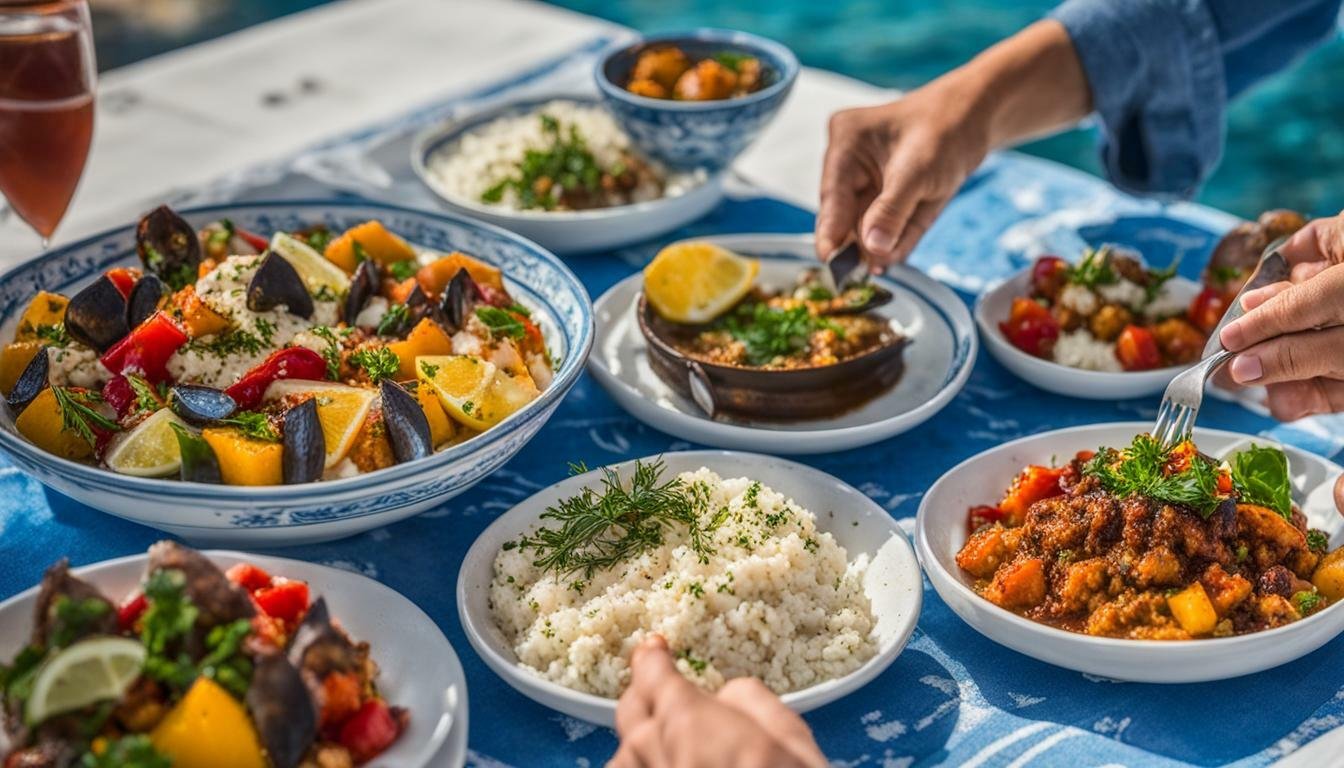Take Me to the Recipes
Greece, the land where ancient myths dance with modern marvels, beckons travelers with its sun-drenched shores, captivating history, and legendary cuisine. From the towering monuments of Athens to the turquoise waters of Santorini, every corner of this captivating country whispers tales of gods and heroes, philosophers and artists. But Greece is more than just a museum – it’s a vibrant tapestry woven from diverse landscapes, rich traditions, and an irresistible culinary scene.
Savor the symphony of flavors in a plate of moussaka, the creamy layers a testament to generations of culinary wisdom. Bite into a juicy spanakopita, its flaky pastry filled with spinach and feta, a burst of Mediterranean goodness. Let your taste buds dance with grilled octopus kissed by sea salt, each bite a reminder of Greece’s deep connection to the Aegean.
Dive into Antiquity:
Wander through the ruins of the Acropolis, imagining the echoes of gladiatorial battles in ancient Olympia. Explore the Minoan labyrinth of Knossos, where legends of Theseus and the Minotaur come alive. Let history unfold as you walk in the footsteps of Aristotle and Socrates, their philosophies still shaping our world today.
Embrace the Landscape:
Sail through the Aegean Sea, past volcanic islands bathed in golden light. Trek through rugged mountain ranges, their slopes dotted with charming villages and ancient monasteries. Breathe in the fresh air of olive groves and sun-kissed vineyards, the very source of Greece’s culinary treasures.
Join me as we sample the flavors that make Greek food so special!
Take Me to the Recipes
Greek Cuisine – Key Takeaways
- Greek cuisine is a reflection of the country’s rich history and cultural traditions.
- Moussaka is the national dish of Greece and is a beloved classic in Greek households.
- Spanakopita, a delicious Greek spinach pie, is a staple in Greek cuisine.
- Souvlaki is a popular Greek street food that has gained fame worldwide.
- Greek food has made an impact worldwide with its authentic recipes and delicious flavors.
Where is Greece

Greece is located in South Eastern Europe, bordering the Ionian Sea and the Mediterranean Sea. It is a peninsular country, with an archipelago of about 3,000 islands.

Index of the Contents
- Take Me to the Recipes
- More Articles
- Interesting Facts About Greece
- Greek History and the Effect It Has Had on the Cuisine
- How Greece’s Climate and Geography has Influenced Greek Cuisine
- Understanding the Essence of Greek Cuisine
- Greek Culinary Traditions
- Exploring the Greek Ingredients: The Flavors of Greece
- Greek Food: A Taste of History and Tradition
- The National Greek Food
- Popular Greek Food
- How Healthy is Greek Food?
- Greek Food Dishes you can try in your own Kitchen
- Conclusion
- FAQ’s
You may also be interested in the following articles
- North and South American Cuisine – A Culinary Expedition
- Europe Cuisine: Savor the Continent’s Best Culinary Secrets!
- African Cuisine: Discover the Bold Flavors & Global Charm!
- Asian Cuisine Unlock its Secrets – Taste, Health & Global Influence!
Savor iconic Greek Food Recipes – Click on each tantalizing picture to open up the Recipe.
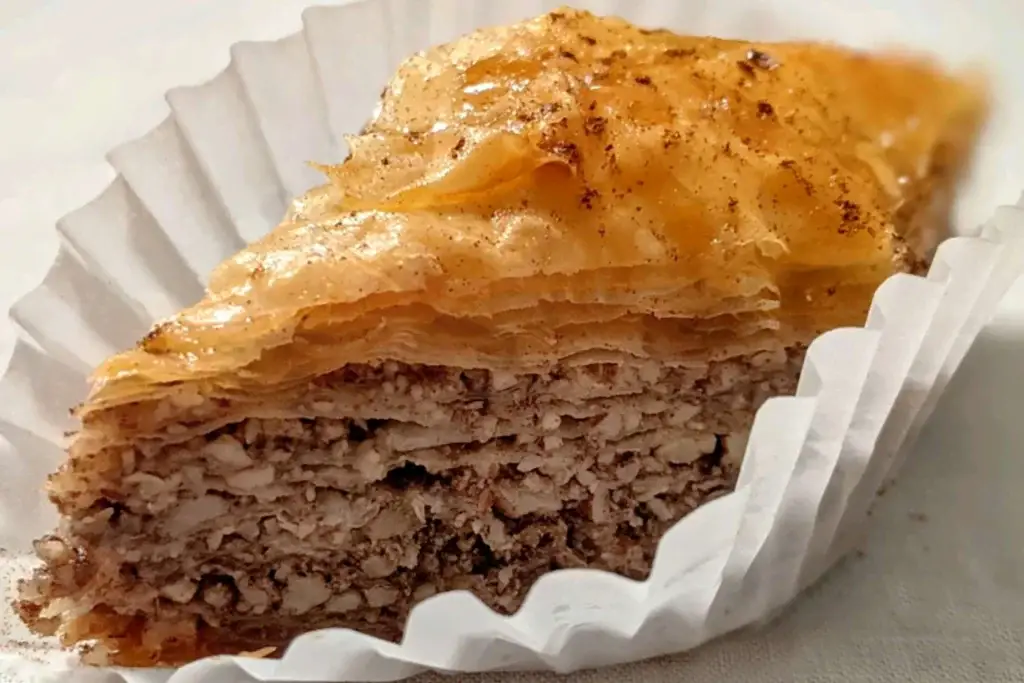

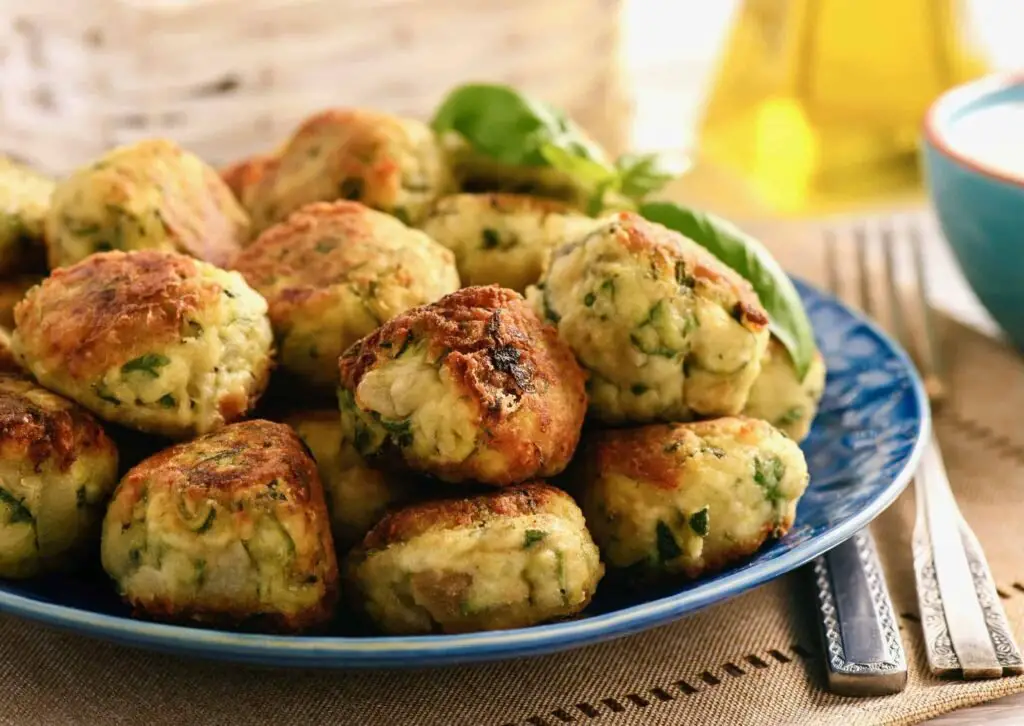
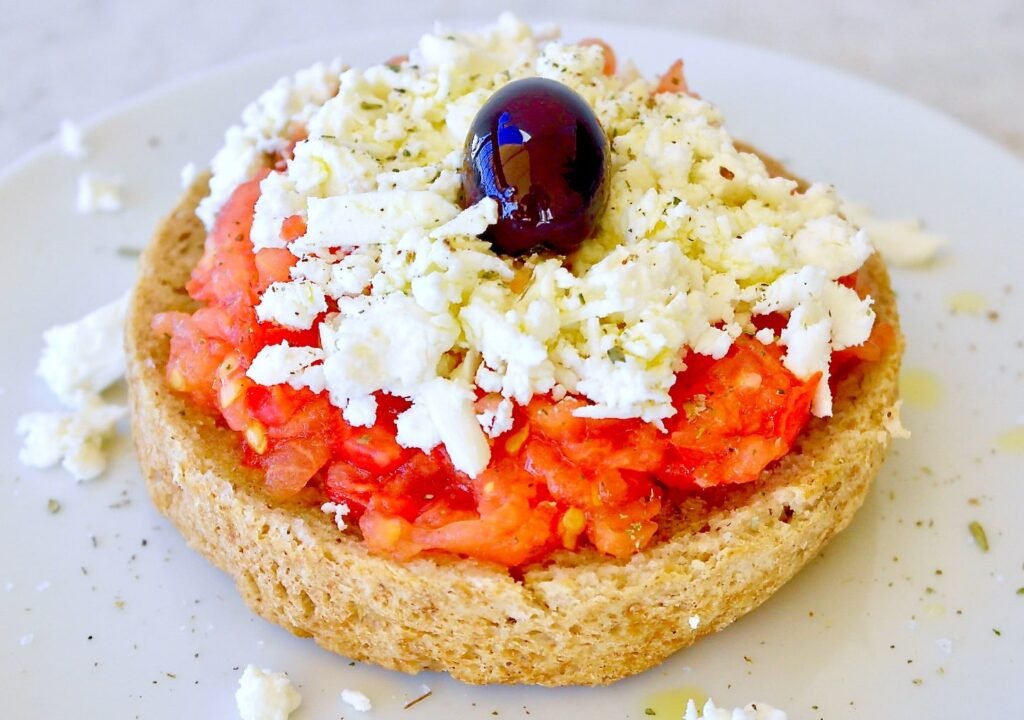
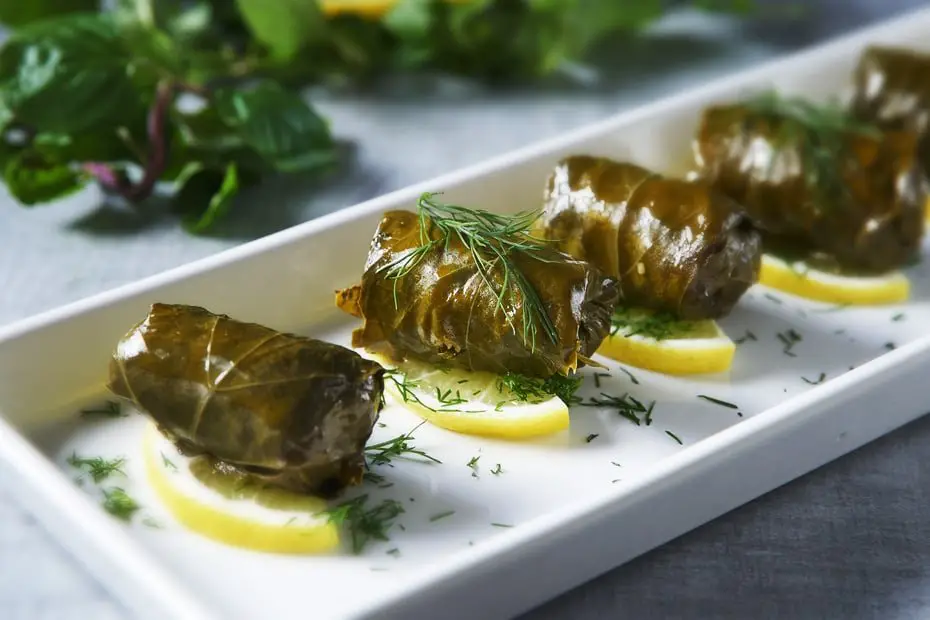
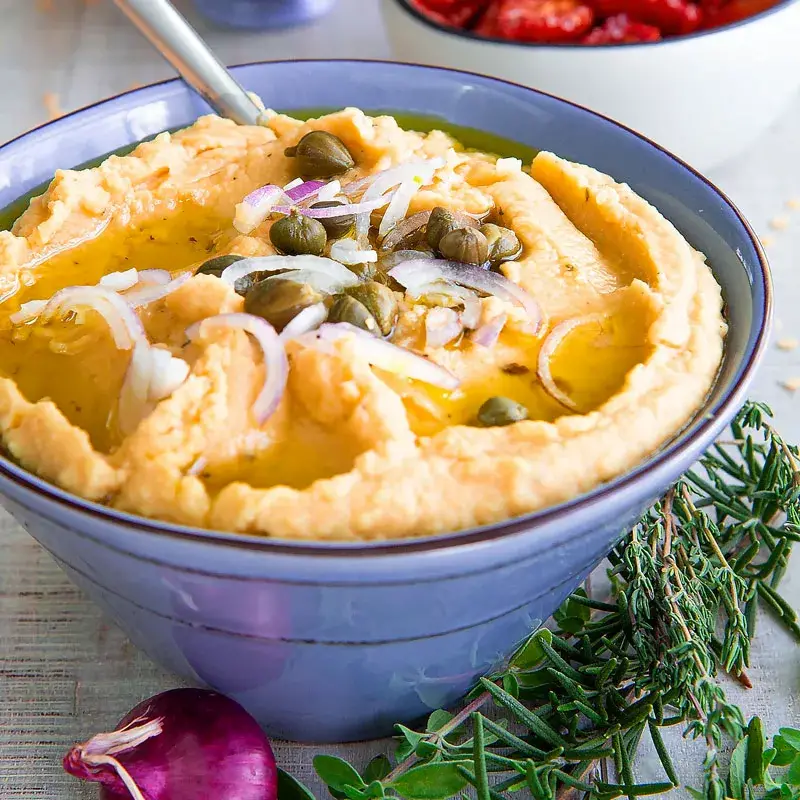

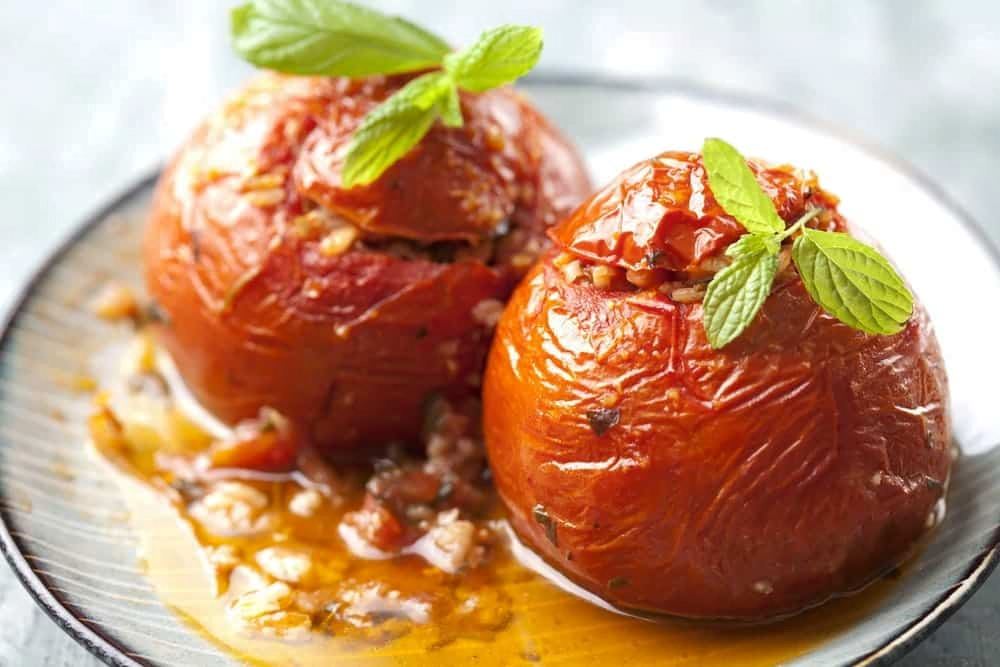
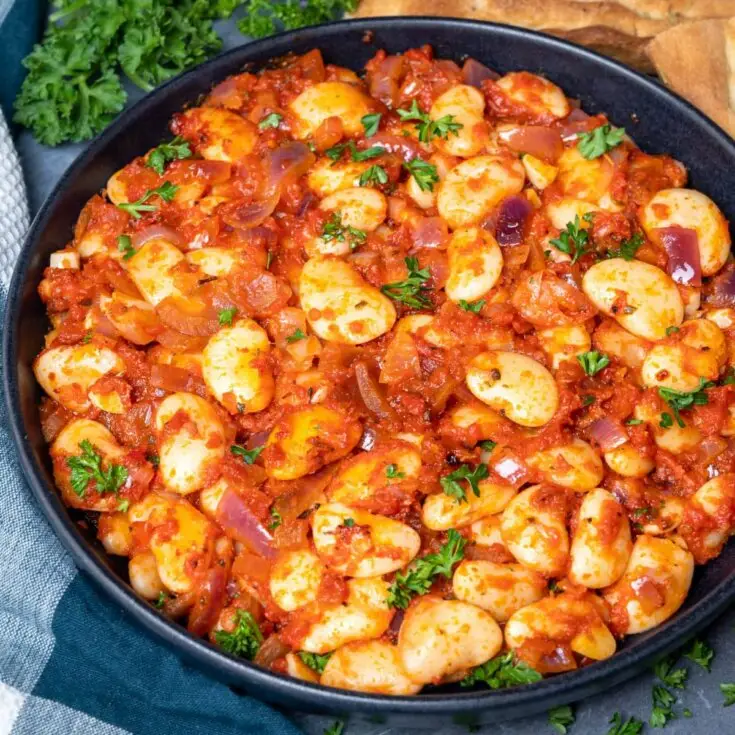
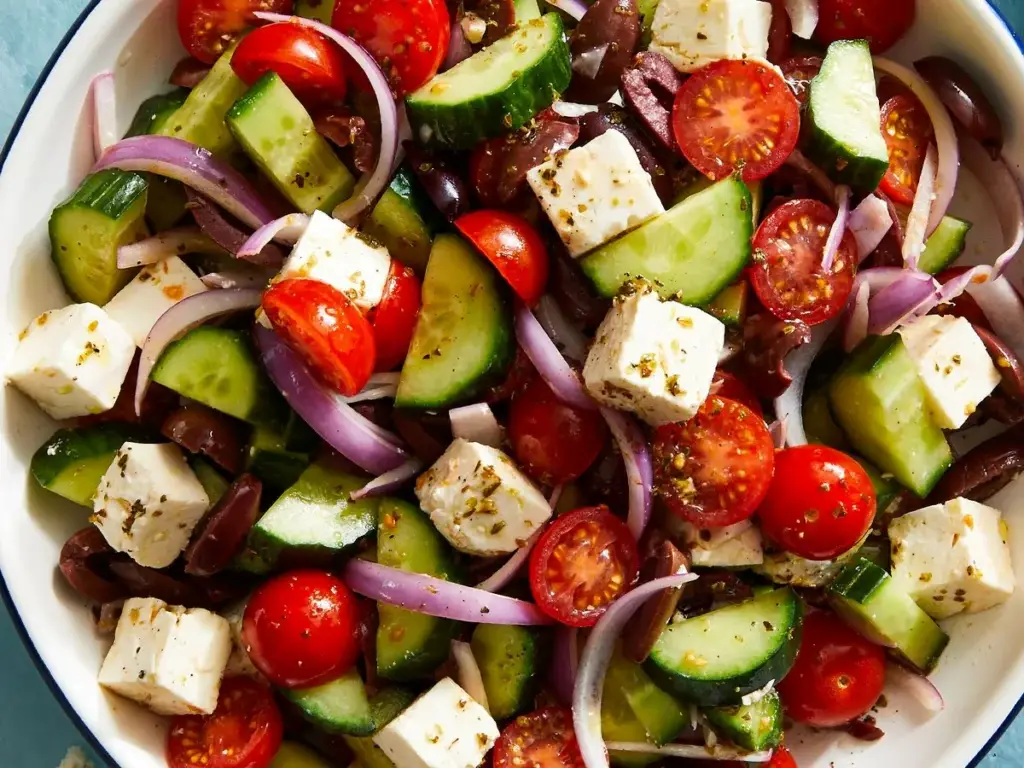
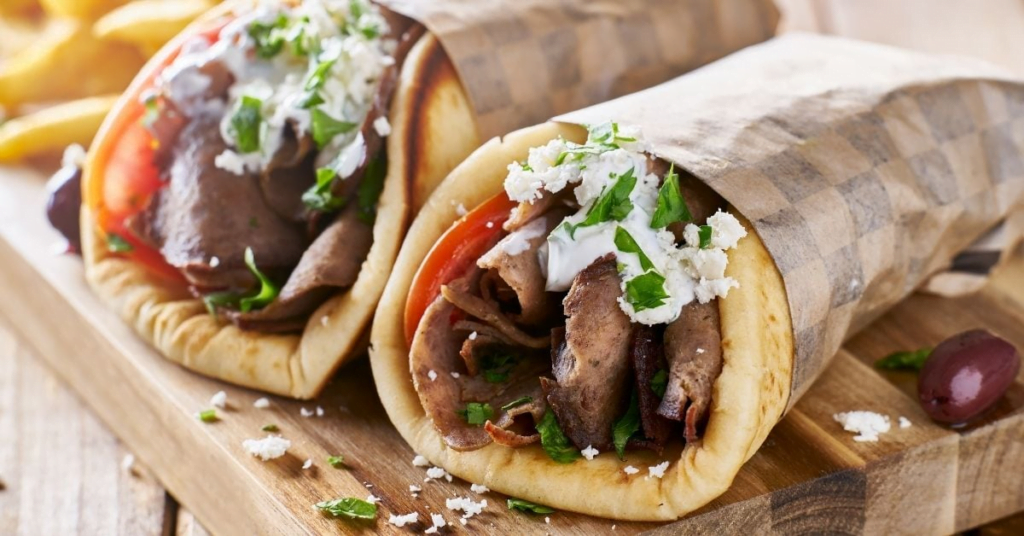
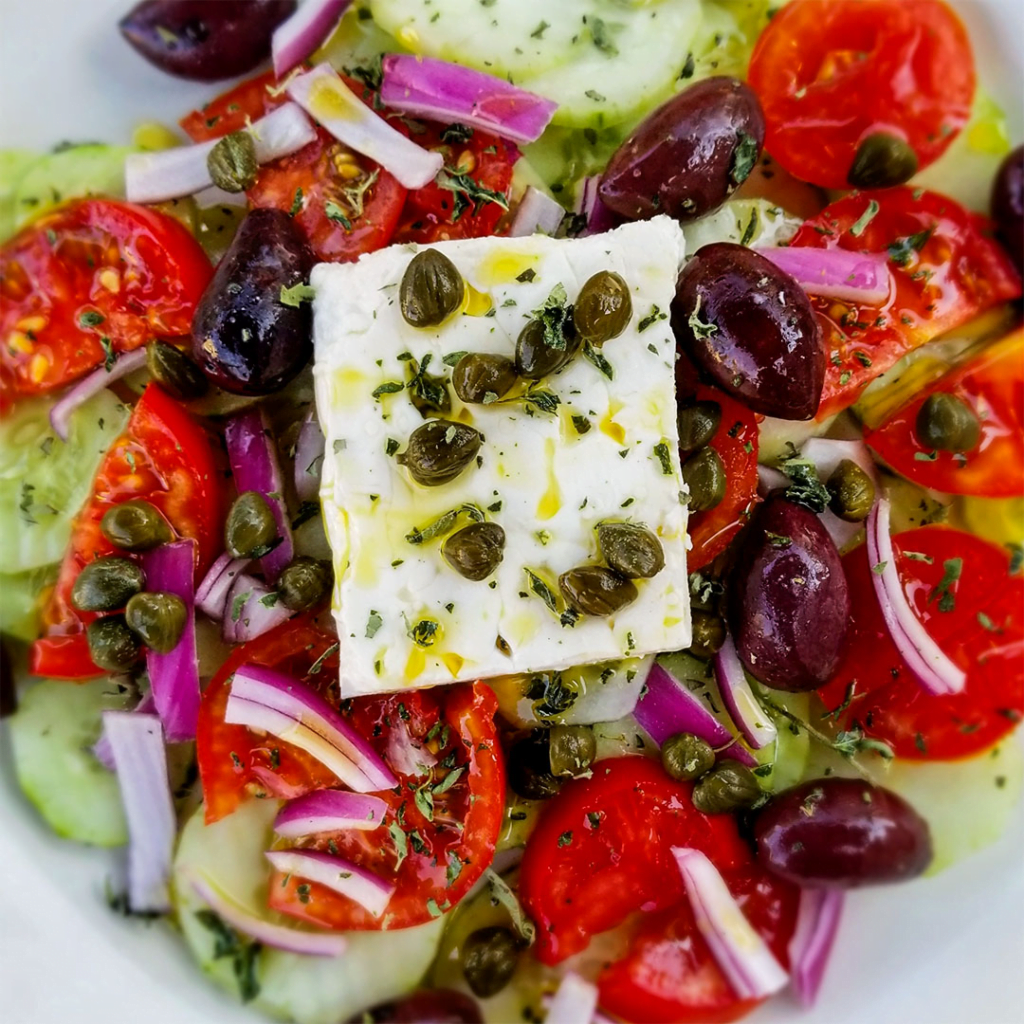
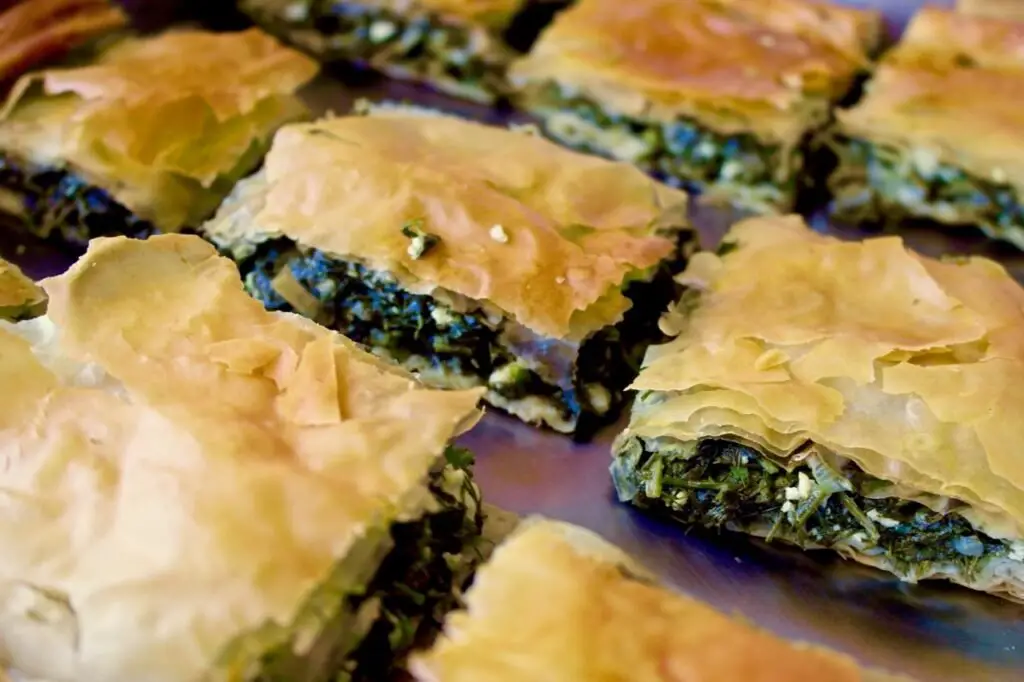
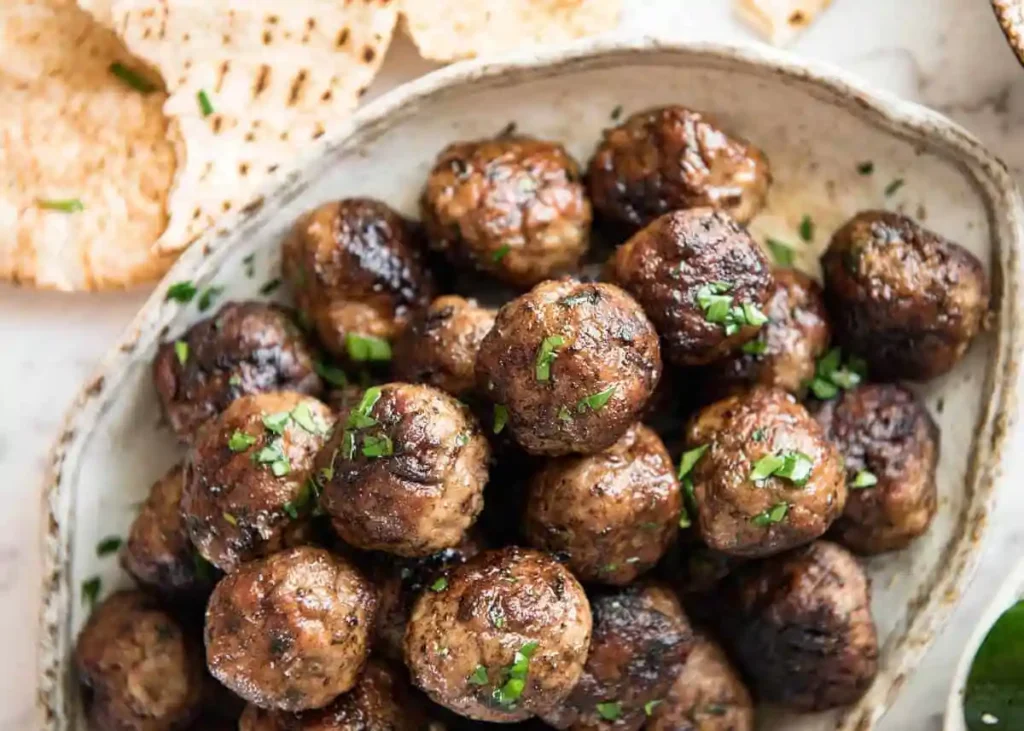
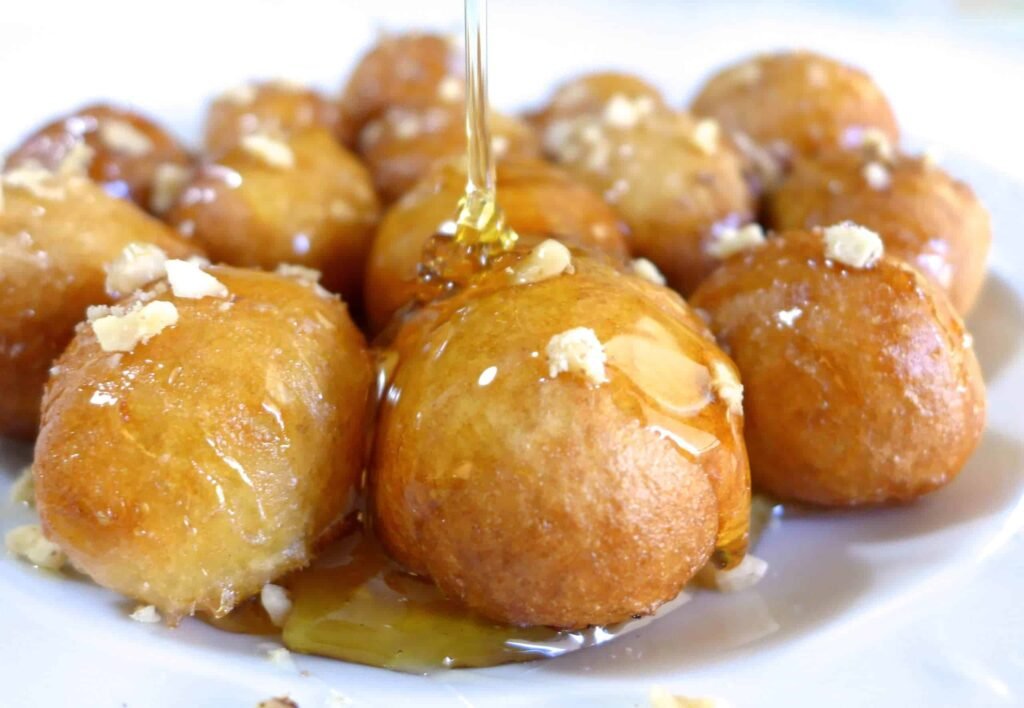
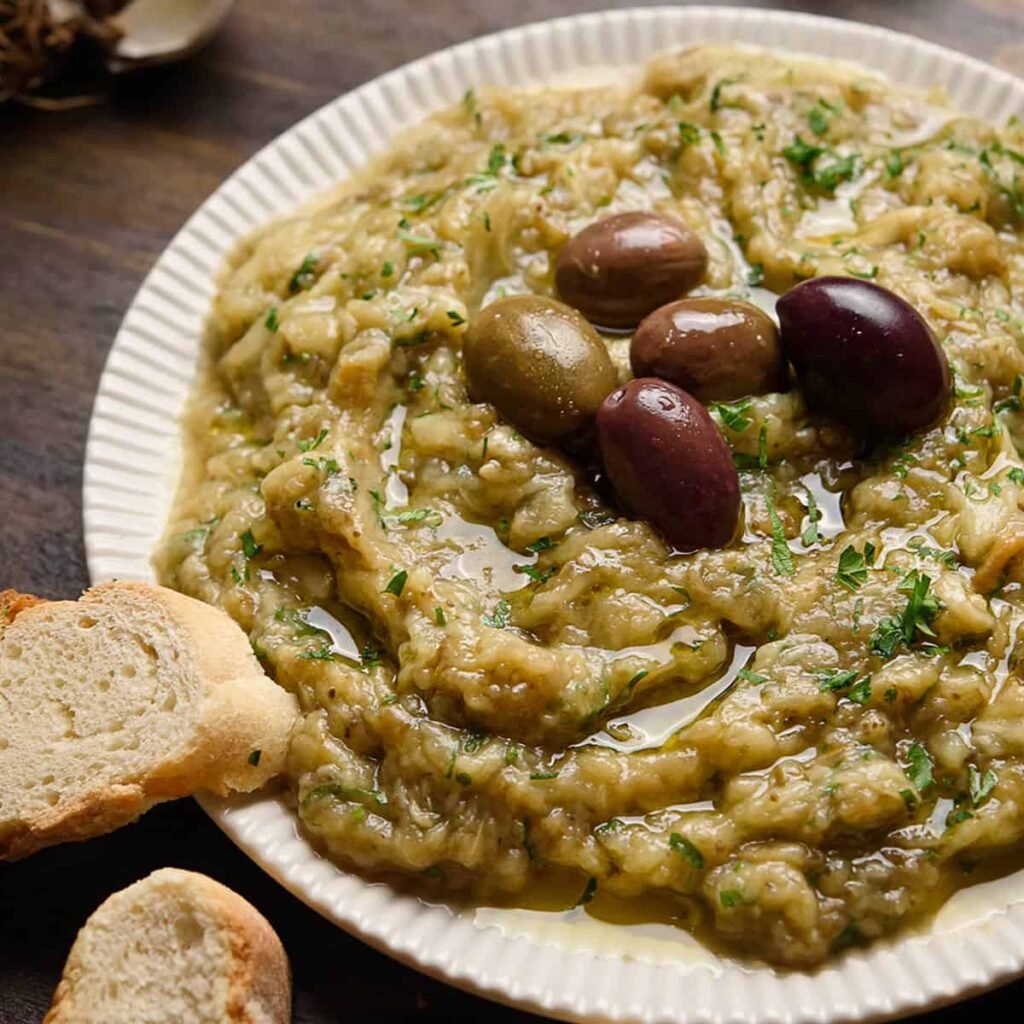
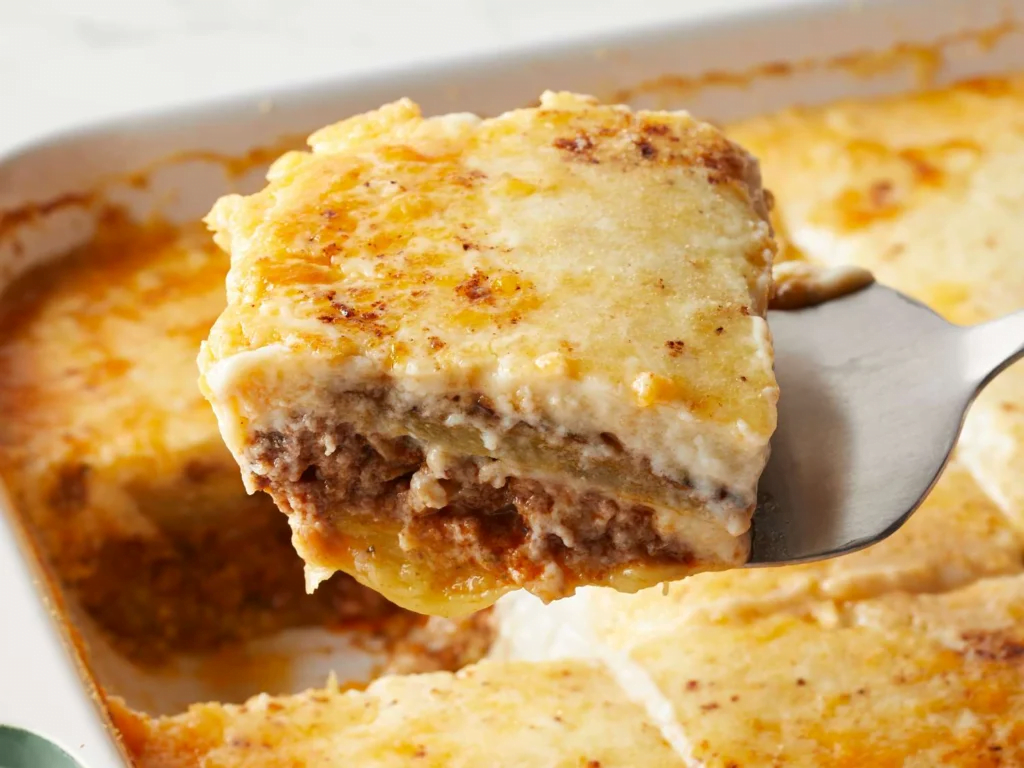
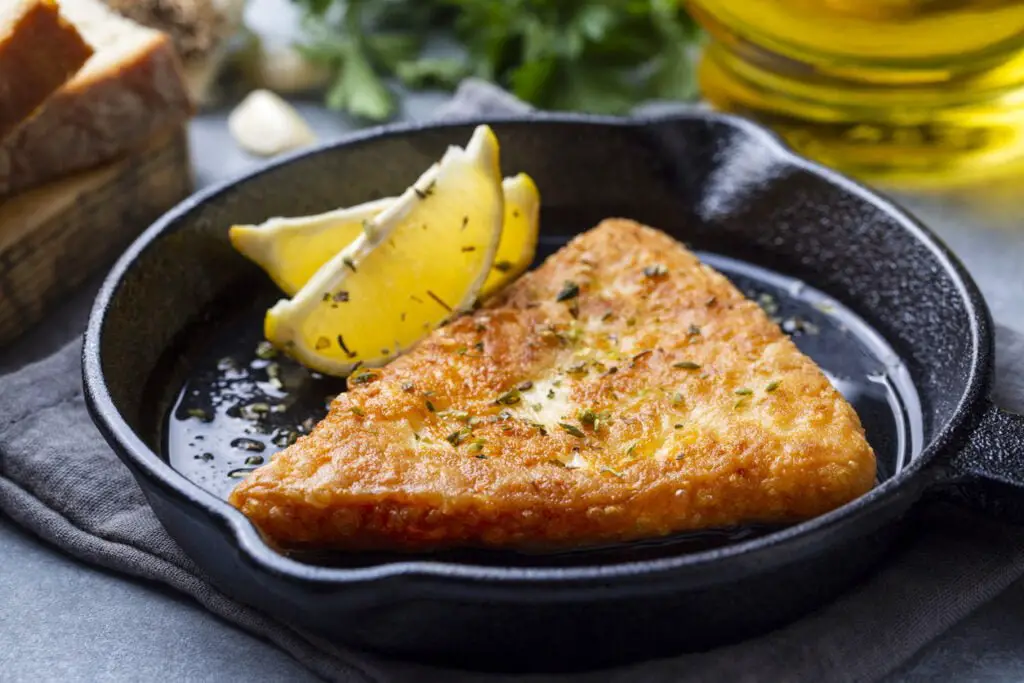
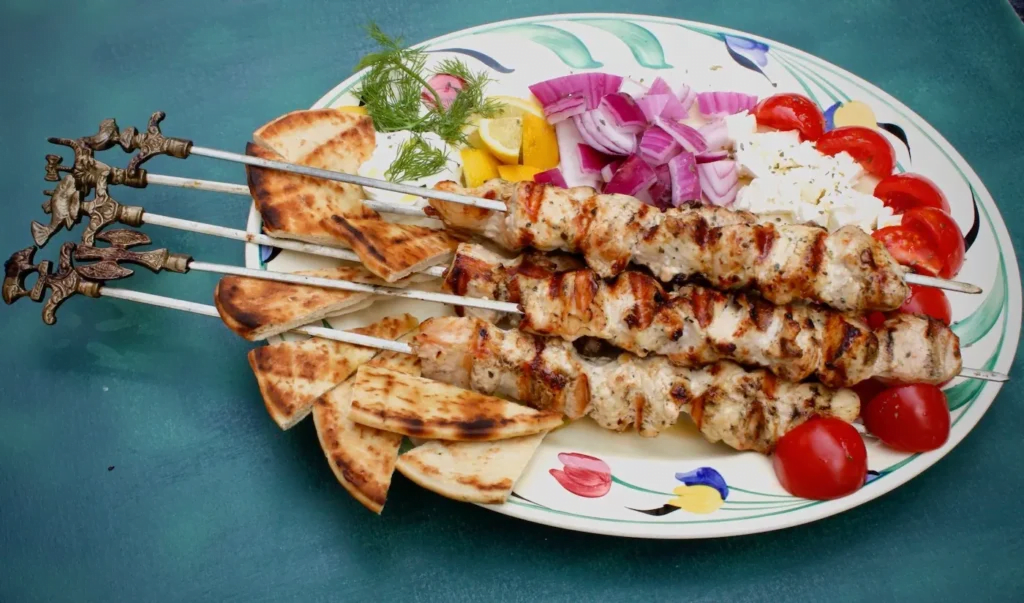
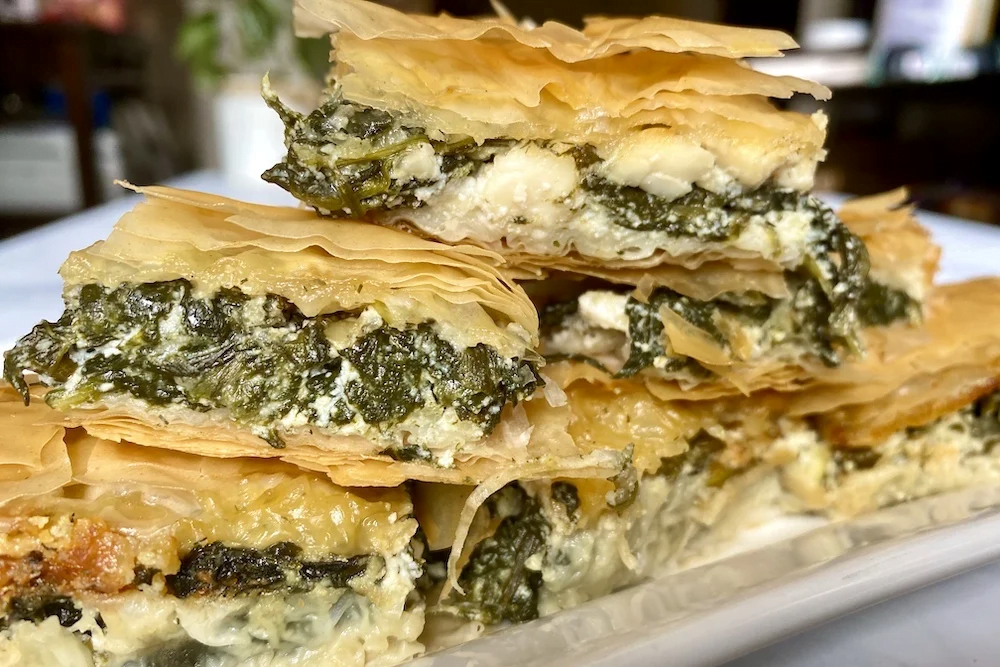
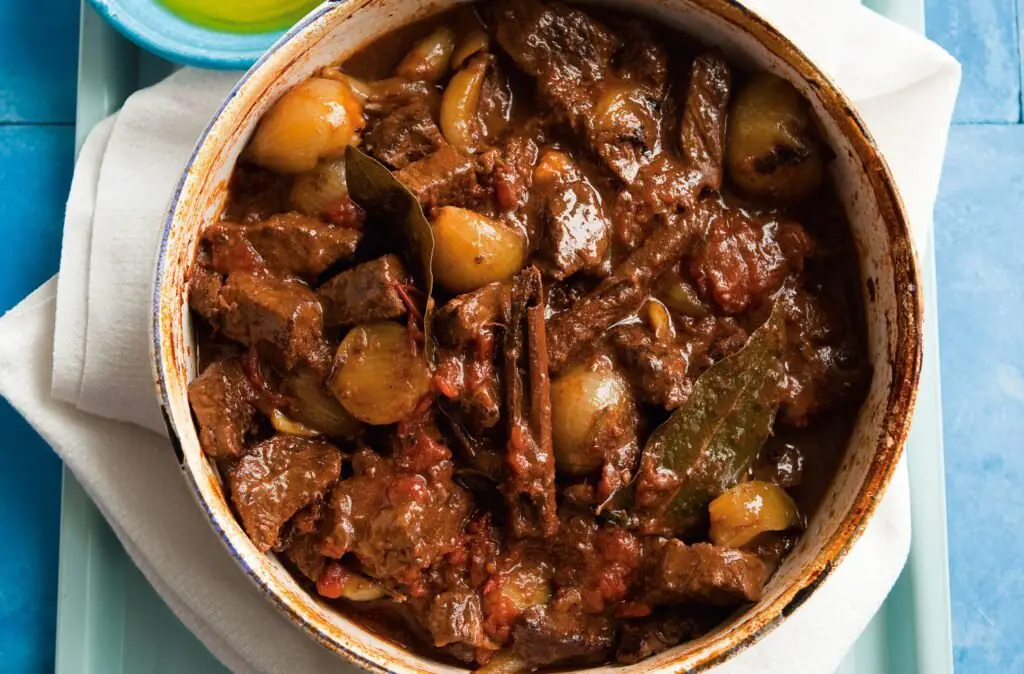
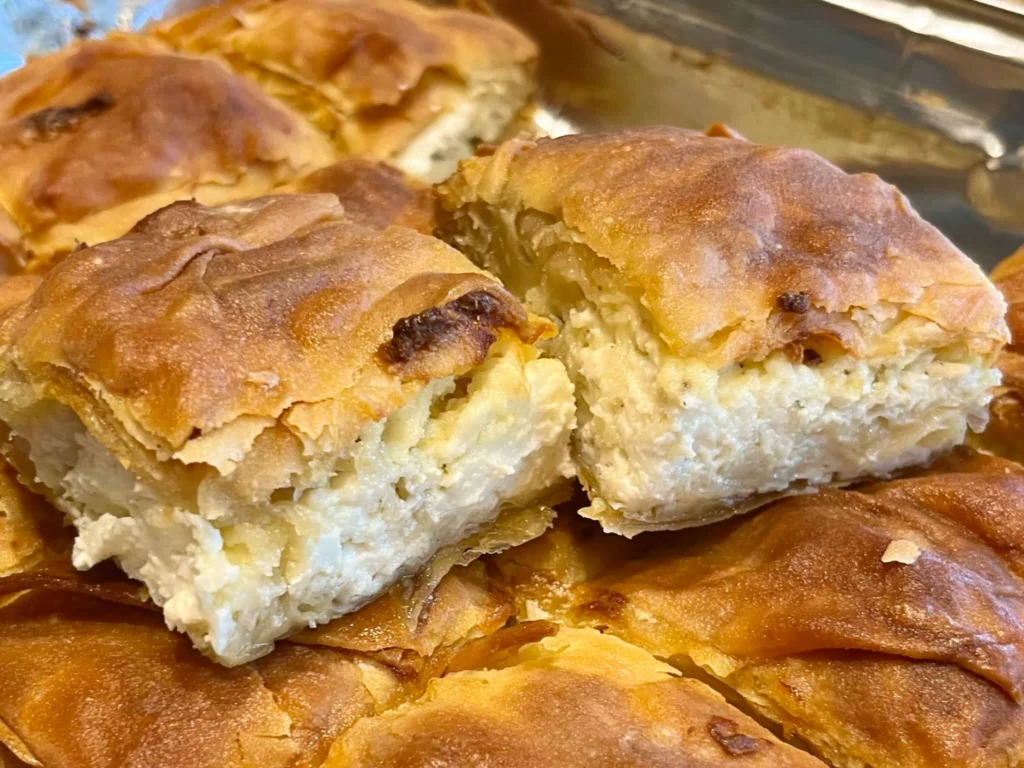
- Greek Salad
- Tiropita
- Moussaka: The Quintessential Greek Dish
- Spanakopita: A Greek Spinach Pie
- Souvlaki: A Greek Street Food Favorite
- Galaktoboureko
- Baklava
Interesting Facts About Greece
Think Greece and images of whitewashed houses, ancient ruins, and delicious food come to mind. But there’s more to this sun-kissed land than meets the eye! Brace yourself for 10 quirky facts that will leave you saying “opa!” to a whole new understanding of Greece:
Cat Island Paradise

Feline fans rejoice! A tiny island called Aegina boasts a resident cat population exceeding human inhabitants. Purrfect for catnaps on sun-drenched beaches!
Monasteries on Stilts
Meteora monasteries defy gravity, perched atop towering sandstone pillars. Breathtaking views and a touch of mysticism await adventurous climbers.
Sponge Divers & Treasure Hunters
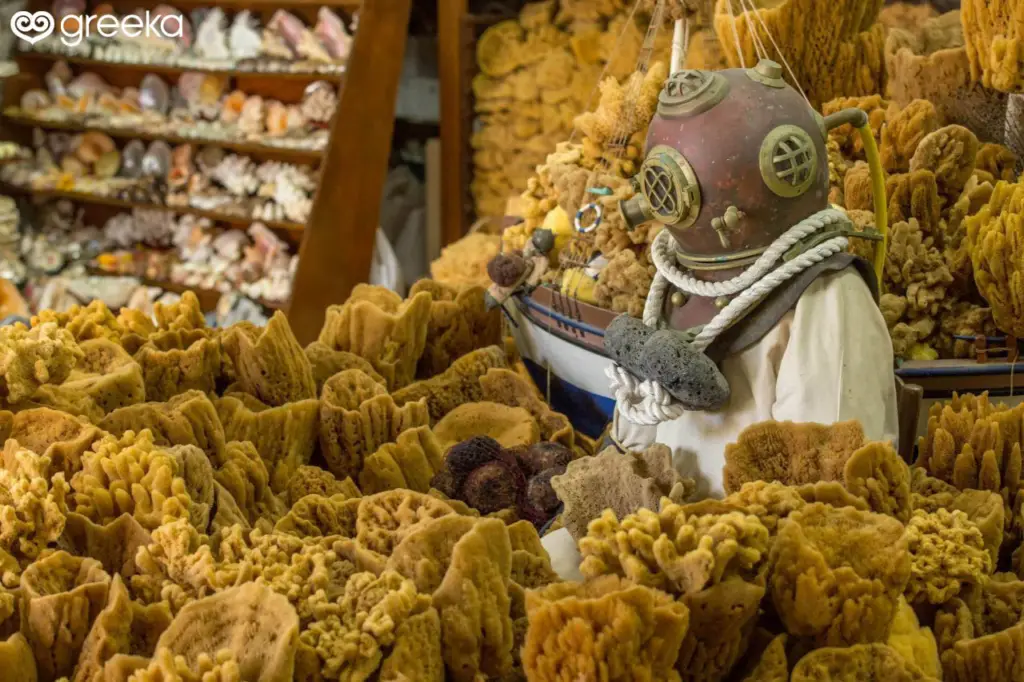
Greece is the world’s top producer of natural sponges, harvested by intrepid divers who also happen to be skilled underwater archaeologists, often unearthing ancient treasures!
Donkey Taxi?
On Santorini, donkeys were once the primary mode of transport. Today, tourists can still experience these furry “taxis” for a unique island adventure. (Animal welfare is always a priority, and these tours are regulated.)
Olympic Flame, Ancient Style
Ancient Greeks used giant mirrors to light the Olympic torch during their games, harnessing the power of the sun itself! Talk about sustainable fire!
The Mystery of the Minotaur

Knossos Palace, home of the mythical Minotaur, boasts Europe’s oldest city, dating back over 9,000 years. Explore its labyrinthine corridors and imagine mythical encounters!
Coffee Culture Craze
Greeks hold the title of Europe’s biggest coffee consumers, averaging a whopping 5 cups daily! Fuel your inner philosopher with a strong brew in a traditional “kafenio.”
Ancient Vending Machines

Ever seen a 2,000-year-old vending machine? In Athens, discover the “Enkleros,” an ancient device dispensing holy water to thirsty worshippers.
Island Hopping Wonderland

With over 6,000 islands, Greece offers endless island-hopping adventures. Discover hidden coves, charming villages, and crystal-clear waters – a beach lover’s paradise!
So, ditch the stereotypical image and dive deeper into the fascinating world of Greece. Whether you’re a history buff, a nature lover, or simply seeking a unique travel experience, Greece has something to surprise and delight you!
Greek History and the Effect It Has Had on the Cuisine

The magic of Greek food is that it is a delightful tapestry woven from thousands of years of delicious evolution. From the sun-drenched shores of antiquity to the vibrant markets of today, let’s embark on a journey exploring how each era left its unique flavor on Greek cuisine:
The Dawn of Flavor: The Archaic Period (800-480 B.C.)
Picture bustling marketplaces filled with the aroma of freshly baked bread, the tang of vibrant olives, and the inviting notes of homemade wine. These simple yet essential ingredients formed the foundation of the Greek diet, their flavors enhanced by the warm Mediterranean climate that nurtured olive and lemon trees, now iconic elements of Greek cooking.
Herbs like oregano, basil, mint, and thyme added bursts of freshness, while the abundance of coastlines offered an endless bounty of fish and seafood, forever shaping the Greek palate.
The World on a Plate: The Classical Period (480-323 B.C.)
Think epic conquests and a fusion of cultures. Alexander the Great’s vast empire stretched from Europe to India, bringing with it a wave of culinary influences. Northern and eastern flavors permeated Greek kitchens, adding new spices and techniques to the existing repertoire.
Later, when Greece fell to the Romans in 146 B.C., their culinary traditions further enriched the already diverse mosaic of Greek cuisine.
A Symphony of Spices: The Hellenistic Period (323-31 B.C.)
Constantinople, the heart of the Byzantine Empire, set the stage for a new chapter. Here, Greek cuisine absorbed influences from its powerful neighbor, creating a unique blend of flavors. Centuries later, Ottoman rule left its mark, with Turkish culinary terms still echoing in classic dishes like tzatziki (derived from the Turkish “cacik”) and dolmades (from the Turkish “dolma”).
This period saw a fascinating fusion of techniques and ingredients, adding another layer to the ever-evolving story of Greek food.
A Return to Roots: The Modern Era (1821-present)
With independence in 1821, Greece witnessed a revival of its cultural heritage, including its beloved cuisine. Today, small farmers across the country proudly produce organic cheeses, oils, fruits, nuts, grains, and vegetables, ensuring the freshest, most authentic flavors.
Rolling hillsides dotted with vineyards yield fine wines and the iconic ouzo, an anise-flavored liqueur cherished for its unique aroma and taste.
The Final Bite: A Legacy of Flavor

In conclusion, Greek cuisine is a captivating blend of the “Mediterranean triad” – wheat, olive oil, and wine – seasoned with influences from Persians, Romans, Byzantines, and Ottomans. Each historical period has left its mark, creating a rich and diverse culinary tapestry that continues to evolve.
So, the next time you savor a plate of Greek food, remember – you’re not just enjoying a delicious meal; you’re experiencing a journey through time.
References
How Greece’s Climate and Geography has Influenced Greek Cuisine

Imagine the sun warming your face as you savor a plate of vibrant Greek food. It’s not just your imagination; the very climate and geography of Greece have shaped its cuisine into the delicious tapestry we know and love. Buckle up for a taste bud adventure as we explore how these factors have influenced every bite:
Sun-Kissed Bounty
Greece basks under a hot, dry climate with endless sunshine. This golden touch is perfect for olive trees, whose precious oil flavors countless dishes. Imagine the zest of lemons, another gift from the luminous sun, adding a refreshing citrus zing to salads and seafood.
From Sea to Plate
Surrounded by the Mediterranean Sea, Greece boasts a treasure trove of fresh seafood. Fishermen haul in an array of treasures, from delicate fish to hearty octopus, each destined to become a star on your plate. Don’t forget the savory marinated olives, a coastal staple bursting with briny goodness.
Local Love
Freshness reigns supreme in Greek cuisine. Local heroes like oregano, basil, mint, and thyme lend their aromatic magic. Eggplant, zucchini, artichokes, and legumes like beans and lentils flourish under the warm sun, ensuring every bite is a celebration of the land.
Olive Oil: The Liquid Gold
The crown jewel of Greek cuisine is undoubtedly olive oil. Used generously for both its flavor and health benefits, it seasons salads, marinades, and cooked dishes, adding a unique richness that can’t be replicated.
Cooking with Tradition
Greek cuisine isn’t shy about showcasing its culinary heritage through traditional techniques. Imagine the smoky aroma of grilled meats, fish, and vegetables sizzling over open flames. Or picture the warm comfort of baked classics like moussaka and spanakopita, their golden crusts concealing layers of deliciousness.
A Fusion of Flavors
Centuries of Byzantine and Ottoman rule have left their mark, weaving their own threads into the Greek culinary tapestry. Spices and herbs from various cultures have found a new home, adding depth and complexity to familiar dishes.
The Final Course
From sun-kissed ingredients to time-honored techniques, Greece’s climate and geography are the secret sauce that makes its cuisine so unique and delicious. It’s a celebration of freshness, simplicity, and tradition, offering a delightful and healthy escape for your taste buds.
So, the next time you encounter a plate of Greek food, close your eyes and imagine the sun-drenched landscapes and vibrant markets that brought it to your table.
References
Understanding the Essence of Greek Cuisine

Greek cuisine isn’t just a collection of dishes; it’s a harmonious symphony of freshness, simplicity, tradition, and cultural influences, all shaped by the unique land, sun, and sea that Greece embodies. Here’s what makes it truly stand out:
Sunlight-Kissed Ingredients
Imagine biting into a juicy olive, its flavor a testament to the warm, dry climate that nurtures these iconic trees. Picture the tangy zest of lemons, another gift of the sun, adding a refreshing kiss to salads and seafood.
The very foundation of Greek cooking is built upon the freshness and vibrancy of locally sourced ingredients like vegetables kissed by the sun, aromatic herbs like oregano and mint, and legumes that thrive in the fertile soil.
Liquid Gold: The Power of Olive Oil
More than just an ingredient, olive oil is the lifeblood of Greek cuisine. Drizzled on salads, used for cooking, and even enjoyed on its own with bread, it adds a distinctive richness and healthfulness. This “liquid gold” embodies the essence of the Mediterranean diet, promoting good health and longevity.
From Sea to Plate: A Bounty of Freshness
Surrounded by the sparkling Aegean and Ionian Seas, Greece boasts a treasure trove of seafood. Imagine the delicate flavors of freshly caught fish, the tender bite of octopus, and the salty tang of mussels, all brought directly from the sea to your plate.
This reliance on seafood reflects the deep connection between Greek culture and the Mediterranean bounty.
Simple Techniques, Timeless Appeal
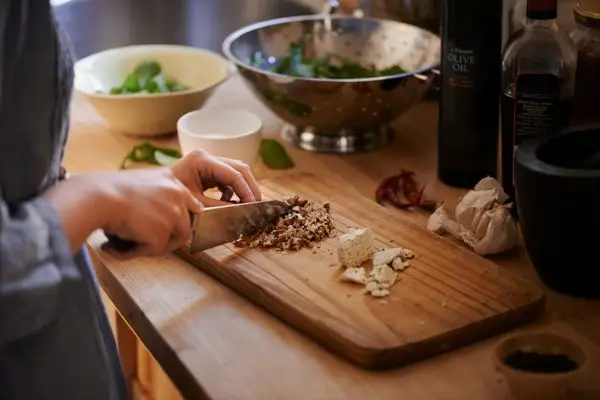
Greek cooking celebrates simplicity. Dishes like grilled meats and vegetables, seasoned with just the right herbs and olive oil, showcase the natural flavors of the ingredients. Traditional methods like baking in clay pots add an earthy depth.
Dishes like stuffed grape leaves (dolmades) and spanakopita (spinach pie) demonstrate the art of transforming simple ingredients into culinary masterpieces.
A Tapestry of Influences
Over millennia, Greece has been a crossroads of civilizations, and its cuisine reflects that rich tapestry. Byzantine and Ottoman influences are evident in spices and techniques, while the Romans left their mark in the use of wine and cheese.
This fusion of cultures adds complexity and depth to Greek food, making it more than just the sum of its parts.
More Than Just Food: A Celebration of Life
Sharing a meal in Greece is about more than just sustenance; it’s a celebration of life, community, and tradition. Food is meant to be savored, enjoyed with loved ones, and accompanied by laughter and conversation. This emphasis on conviviality and social connection is an integral part of the essence of Greek cuisine.
The essence of Greek cuisine lies in its freshness, simplicity, tradition, and cultural influences. From the sun-kissed ingredients to the time-honored techniques, from the bounty of the sea to the warmth of shared meals, every element comes together to create a unique and delicious experience that nourishes both body and soul.
Greek Culinary Traditions

Greek culinary traditions are steeped in both ritual and spontaneity. From the religious fasting of the Orthodox Church to the spontaneous “glendi” or feast, food is an expression of cultural identity.
Dishes like moussaka and souvlaki are not just meals but narratives of history and community. The tradition of “mezedes,” small plates shared among friends, showcases the Greek way of life, one that is leisurely, social, and generous.
These traditions, from the simple village taverna to the bustling city “estiatorio,” are a testament to the enduring Greek philosophy that food is life.
Exploring the Greek Ingredients: The Flavors of Greece

The flavors of Greece are a palette of land and sea, sun and wind:
- Olive Oil: The liquid gold of Greek cuisine, used liberally in cooking and dressings.
- Olives: Eaten on their own or added to dishes for a burst of flavor.
- Feta Cheese: The crumbly, tangy cheese that graces salads and pastries.
- Seafood: Fresh from the Mediterranean, often grilled or baked with lemon and herbs.
- Lamb: A favored meat, roasted or grilled to succulent perfection.
- Yogurt: Thick and creamy, a staple in Greek cooking and baking.
- Honey: Drizzled over sweets and used in a variety of desserts.
- Herbs: Oregano, thyme, and mint are used to season dishes with the essence of the Greek landscape.
These ingredients, woven together through centuries of tradition and innovation, create a cuisine that is hearty yet healthy, complex yet unpretentious, and always deliciously Greek.
Greek Food: A Taste of History and Tradition

When it comes to Greek food, there’s so much more to discover beyond just moussaka or souvlaki. Greek cuisine is a reflection of the country’s rich history and cultural traditions, and it’s evident in the delicious flavors and ingredients that define it.
For centuries, Greeks have placed great importance on food, considering it a way to bring people together and share their culture. From the use of fresh herbs and spices to the prominence of olive oil, Greek gastronomy is steeped in tradition and reflects a deep connection to the land.
One of the most iconic aspects of Greek cuisine is the use of simple, fresh ingredients to create dishes that are both flavorful and healthy. Whether it’s a simple Greek salad with fresh tomatoes and feta cheese or a hearty dish like spanakopita, the emphasis is always on quality ingredients and simple preparation.
Another essential component of Greek cuisine is the concept of meze, which refers to a variety of small dishes that are meant to be shared and enjoyed as part of a larger meal. Meze can include everything from dips like tzatziki and melitzanosalata (eggplant dip) to savory pastries like tiropita (cheese pie) and bougatsa (phyllo pastry with custard cream).
The next time you sit down to enjoy a plate of moussaka or savor a skewer of souvlaki, remember that you’re experiencing a taste of history and tradition.
The National Greek Food
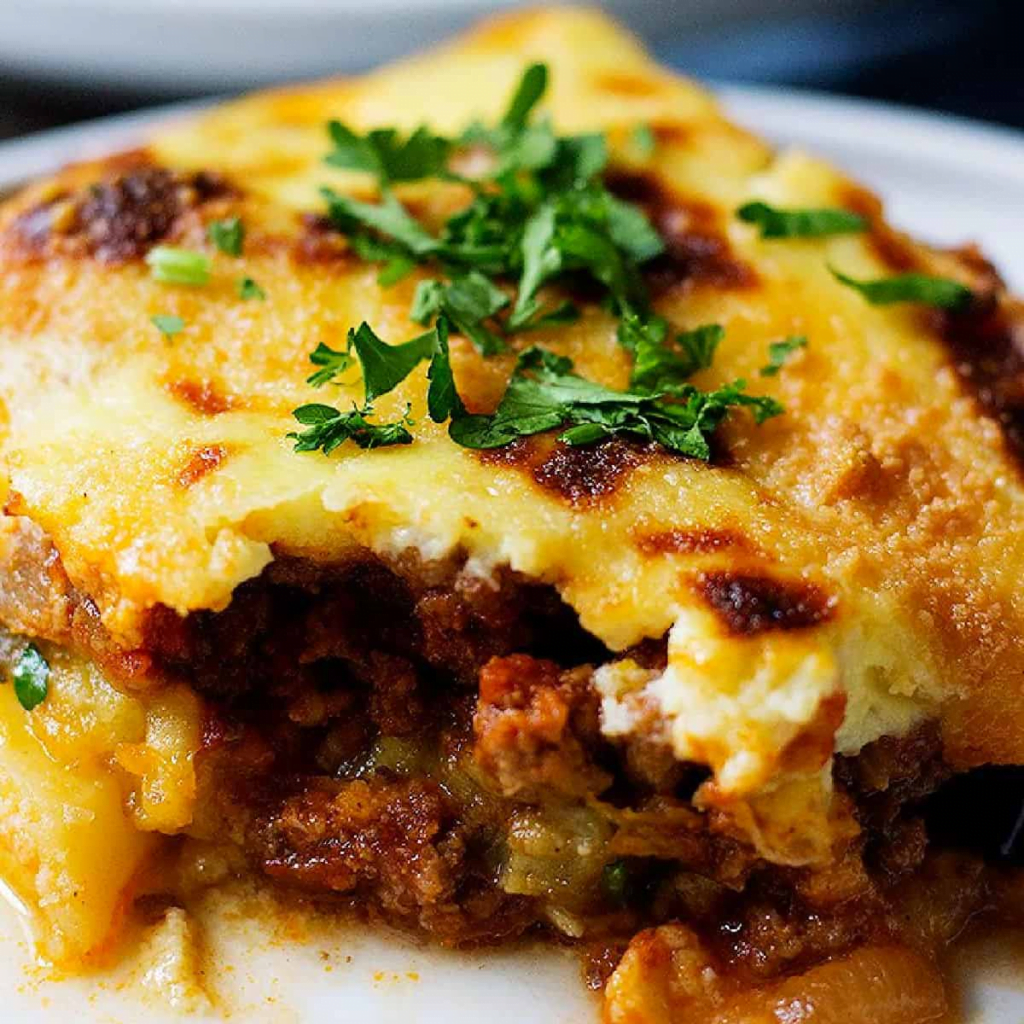
National Greek food is known for its rich flavors and fresh ingredients. It incorporates traditional Mediterranean ingredients such as olive oil, feta cheese, and lemon juice. Popular dishes include moussaka, souvlaki, and spanakopita.
Greek cuisine is celebrated for its healthy and vibrant flavors, making it a beloved choice worldwide.
Popular Greek Food
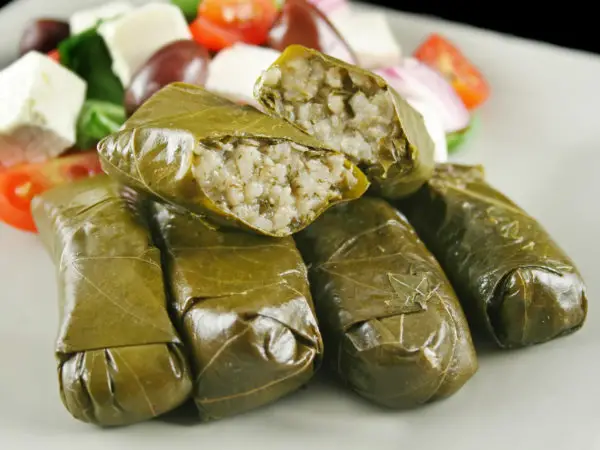
- Moussaka: Creamy eggplant lasagna, kissed by cinnamon.
- Souvlaki: Grilled meat skewers, dancing with smoky aroma.
- Spanakopita: Spinach and feta embrace in flaky pastry heaven.
- Dolmades: Stuffed grape leaves, secrets whispered in each bite.
- Gyros: Pita pockets overflowing with meaty, garlicky goodness.
- Fava: Split pea puree, smooth and dreamy on warm bread.
- Pastitsio: Macaroni masterpiece, layered with meaty delight.
- Choriatiki Salata: Rustic symphony of tomatoes, olives, and feta.
- Gigantes Plaki: Giant beans braised in tomato sauce, slow-cooked comfort.
- Gemista: Stuffed peppers and tomatoes, bursting with sunshine flavors.
- Stifado: Beef stew with onions and spices, a warm hug in a bowl.
- Keftedes: Meatballs with fluffy interiors and savory secrets.
- Melitzanosalata: Smoky roasted eggplant dip, smoky and addictive.
- Saganaki: Flamed cheese, a salty, crispy, melty spectacle.
- Dakos: Cretan barley rusk salad, soaked in tomatoey goodness.
- Hortopita: Wild greens pie, nature’s bounty in flaky embrace.
- Loukoumades: Honey donuts, fluffy bites soaked in sweet delight.
- Bougatsa: Creamy custard in phyllo pastry, a breakfast fit for kings.
- Galaktoboureko: Custard and semolina pie, swimming in sweet syrup.
- Baklava: Layers of pastry and nuts, drenched in honeyed joy.
How Healthy is Greek Food?

Forget bland, boring diets! Greek food is your passport to taste bud nirvana and a healthier you. Why? Because it’s the heart of the Mediterranean diet, consistently ranked among the world’s best. Dive into the delicious details:
A Feast for Body and Soul
Imagine meals built around healthy fats, whole grains, vibrant veggies, and fresh seafood. That’s the Greek way, focusing on ingredients like:
- Olive oil: This liquid gold, rich in antioxidants and anti-inflammatory powers, fuels your body and protects your heart.
- Fresh, local produce: Think sun-kissed tomatoes, juicy olives, and fragrant herbs – bursting with vitamins and flavor.
Dishes that Delight and Nourish
Craving specifics? Here are some Greek heroes:
- Hummus: Packed with protein, fiber, and healthy fats, it’s a dip-tastic dream.
- Melitzanosalata: Smoky roasted eggplant dip, loaded with antioxidants and bursting with garlicky goodness.
- Fish and seafood: From salmon to octopus, these omega-3 powerhouses keep your heart happy and your mind sharp.
More Than Just Tasty Bites
The benefits go beyond the plate:
- Heart health: Studies show the Mediterranean diet slashes your risk of heart disease, stroke, and other cardiovascular woes.
- Digestive health: Yogurt and fiber-rich veggies promote a happy gut, essential for overall well-being.
- Weight management: Portion control and nutrient-dense ingredients are your allies in maintaining a healthy weight.
- Antioxidant haven: Free radicals tremble! Greek cuisine fights them off with its antioxidant-rich bounty.
Living Proof: The Greek Advantage
Greeks aren’t just enjoying delicious food; they’re living longer, healthier lives! Here’s the evidence:
- Impressive life expectancy: Both men and women in Greece enjoy longer lives compared to many other countries.
- Lower obesity rates: The balance and moderation ingrained in Greek culture translate to healthier weights.
- Active lifestyles: Greeks tend to embrace movement, further boosting their well-being.
Challenges and Continued Strides
Of course, no system is perfect. The Greek healthcare system faces challenges, but efforts are underway to improve accessibility and quality.
The Takeaway
Greek food isn’t just a culinary adventure; it’s a path to a healthier, happier you. So, grab some olives, fire up the grill, and embrace the Greek way to deliciousness and well-being!
References
- data.who.int
- healthreporter.com
- mostnutritiousfoods.com
- worldlifeexpectancy.com
- eurohealthobservatory.who.int
- healthline.com
- population.un.org
- data.unicef.org
- unstats.un.org
Greek Food Dishes you can try in your own Kitchen
Are you ready to try your hand at Greek cooking? With a few key ingredients and some simple techniques, you can bring the authentic taste of Greece into your own kitchen. Here are some recipes to get you started:
Greek Food – Dolmades: Stuffed grape leaves, secrets whispered in each bite.

Exploring Greek Delights: Dolmades Unveiled
Embark on a culinary journey to the heart of Greece with the enchanting dish known as Dolmades. These delectable stuffed grape leaves encapsulate the rich history and vibrant flavors of Mediterranean cuisine.
As a food enthusiast and the proud owner of a charming restaurant, I’m excited to share the essence of Dolmades – a dish rooted in tradition, meticulously crafted for a burst of Greek flavors.
Greek Food – Ingredients for Dolmades:
- 1 cup grape leaves (fresh or jarred)
- 1 cup short-grain rice
- 1/2 cup olive oil
- 1/4 cup pine nuts, toasted
- 1/4 cup fresh dill, chopped
- 1/4 cup fresh mint, chopped
- 1 onion, finely chopped
- 2 cloves garlic, minced
- 1 lemon, juiced
- Salt and pepper to taste
- 1 1/2 cups vegetable broth
Greek Food – Recipe for Dolmades:
1. Prepare the Grape Leaves:
a. Rinse and Soak: If using jarred grape leaves, rinse and soak them in warm water. For fresh leaves, blanch in boiling water briefly.
2. Prepare the Filling:
- a. Sauté Onion and Garlic: In a pan, sauté finely chopped onion and minced garlic in olive oil until softened.
- b. Combine Rice and Herbs: Add short-grain rice, toasted pine nuts, chopped dill, chopped mint, salt, and pepper to the pan. Mix well.
- c. Add Lemon Juice: Squeeze the juice of one lemon into the mixture, ensuring a citrusy freshness.
3. Assemble Dolmades:
- Stuff Grape Leaves: Lay out a grape leaf, place a spoonful of the rice mixture in the center, and fold to create a compact roll.
- Arrange in Pot: Place the dolmades seam-side down in a pot, creating layers.
- Pour Vegetable Broth: Pour vegetable broth over the dolmades, ensuring they are immersed.
4. Cook Dolmades:
Simmer: Cover the pot and simmer on low heat for approximately 45 minutes to 1 hour, or until rice is fully cooked.
5. Serve and Enjoy:
Cool and Serve: Allow the dolmades to cool before serving. They can be enjoyed warm or at room temperature.
Serving Information:
- Serves: 4 people
- Preparation Time: 30 minutes
- Cooking Time: 45 minutes to 1 hour
- Calories: 280 per serving
- Protein: 4g
- Fat: 15g
- Carbohydrates: 32g
- Fiber: 3g
- Sodium: 450mg
Delight your taste buds with the exquisite taste of Dolmades, a Greek culinary treasure that invites you to savor the essence of Greece on your plate!
Greek Food – Gyros: Pita pockets overflowing with meaty, garlicky goodness.

Discovering Greek Wonders: The Irresistible Gyros Adventure
Embark on a culinary odyssey to Greece with the tantalizing Gyros, a dish that encapsulates the essence of Mediterranean street food. As both a passionate traveler and the owner of a cozy restaurant, I am thrilled to unravel the history and flavors of Gyros—a delightful blend of seasoned meat, fresh veggies, and creamy tzatziki sauce.
Join me on this culinary escapade through the vibrant streets of Greece.
Greek Food – Ingredients for Gyros:
- 1 lb lamb or chicken, thinly sliced
- 1 large onion, thinly sliced
- 2 tomatoes, thinly sliced
- 4 pita bread rounds
- 1 cup Greek yogurt
- 1 cucumber, grated and drained
- 2 cloves garlic, minced
- 1 lemon, juiced
- 2 tbsp olive oil
- 1 tsp dried oregano
- Salt and pepper to taste
Greek Food – Recipe for Gyros:
1. Marinate the Meat:
- Season the Meat: In a bowl, season thinly sliced lamb or chicken with olive oil, minced garlic, dried oregano, salt, and pepper.
- Marinate: Allow the meat to marinate for at least 30 minutes for optimal flavor.
2. Prepare Tzatziki Sauce
- Grate Cucumber: Grate the cucumber and drain excess water.
- Combine Ingredients: In a bowl, mix Greek yogurt, grated cucumber, minced garlic, lemon juice, salt, and pepper to create the tzatziki sauce.
3. Cook the Meat:
Sear or Grill: Cook the marinated meat on a skillet or grill until fully cooked and slightly charred.
4. Assemble Gyros:
- Warm Pita Bread: Heat the pita bread rounds in a pan or microwave.
- Layer Ingredients: On each pita, layer the cooked meat, sliced onions, and tomatoes.
- Drizzle Tzatziki: Generously drizzle the prepared tzatziki sauce over the layers.
5. Serve and Enjoy:
- Fold and Secure: Fold the pita bread, securing the delicious filling.
- Serve Warm: Serve immediately and savor the authentic flavors of Greek street food.
Serving Information:
- Serves: 4 people
- Preparation Time: 45 minutes
- Cooking Time: 15 minutes
- Calories: 420 per serving
- Protein: 20g
- Fat: 18g
- Carbohydrates: 45g
- Fiber: 3g
- Sodium: 570mg
Embark on a Greek journey through the savory layers of Gyros, a street food sensation that brings the flavors of Greece directly to your plate!
Greek Food – Fava: Split pea puree, smooth and dreamy on warm bread.

Greek Food – Pastitsio: Macaroni masterpiece, layered with meaty delight.
Unveiling Greek Delicacy: Fava Spread on Warm Bread
Embark on a culinary voyage to Greece as we delve into the exquisite simplicity of Fava, a velvety split pea puree that graces warm bread with a touch of Mediterranean magic.
As a globe-trotting food enthusiast and the proud owner of a quaint restaurant, I am thrilled to share the history and flavors of Fava—a dish deeply rooted in Greek tradition.
Join me as we uncover the secrets behind this smooth and dreamy delicacy.
Greek Food – Ingredients for Fava Spread:
- 1 cup yellow split peas, dried
- 1 large onion, chopped
- 2 cloves garlic, minced
- 1/4 cup extra virgin olive oil
- 1 lemon, juiced
- Salt and pepper to taste
- Fresh parsley, for garnish
- Warm bread, for serving
Greek Food – Recipe for Fava Spread:
1. Prepare Split Peas:
Rinse and Soak: Rinse the yellow split peas thoroughly and soak them in water for at least 1 hour.
2. Cook Split Peas:
- Boil: In a pot, combine split peas with enough water to cover. Boil until peas are tender, approximately 20-25 minutes.
- Sauté Onion and Garlic: In a separate pan, sauté chopped onion and minced garlic in olive oil until golden.
3. Blend and Season:
- Drain and Blend: Drain the cooked split peas and blend them with sautéed onion and garlic until smooth.
- Add Lemon Juice: Mix in freshly squeezed lemon juice. Season with salt and pepper to taste.
4. Serve Fava on Warm Bread:
- Spread on Bread: Generously spread the Fava mixture on warm bread slices.
- Garnish: Finish with a drizzle of olive oil and a sprinkle of fresh parsley for a burst of flavor.
Serving Information:
- Serves: 4 people
- Preparation Time: 15 minutes (excluding soaking time)
- Cooking Time: 25 minutes
- Calories: 180 per serving
- Protein: 8g
- Fat: 8g
- Carbohydrates: 21g
- Fiber: 6g
- Sodium: 300mg
Transport your taste buds to the sun-kissed shores of Greece with the delightful Fava Spread, a perfect marriage of simplicity and sophistication that will leave you craving for more.
Greek Food – Horiatiki Salata: Rustic symphony of tomatoes, olives, and feta.

Discovering Greek Essence: Horiatiki Salata Unveiled
Immerse yourself in the culinary wonders of Greece with the iconic Horiatiki Salata, a traditional Greek salad that captures the essence of Mediterranean flavors.
As a passionate food explorer and the proud owner of a cozy restaurant, I am delighted to share the historical roots and regional charm that make this salad a beloved classic.
Join me on a journey to savor the simplicity and freshness of Horiatiki Salata.
Greek Food – Ingredients for Horiatiki Salata:
- 4 large tomatoes, diced
- 1 cucumber, sliced
- 1 red onion, thinly sliced
- 1 green bell pepper, chopped
- 200g feta cheese, crumbled
- 1 cup Kalamata olives, pitted
- 2 tbsp extra virgin olive oil
- 1 tsp dried oregano
- Salt and pepper to taste
Greek Food – Recipe for Horiatiki Salata:
1. Assemble Fresh Vegetables:
- Dice Tomatoes: Prepare fresh tomatoes by dicing them into bite-sized pieces.
- Slice Cucumber: Slice the cucumber into thin rounds for a refreshing crunch.
- Chop Bell Pepper: Chop the green bell pepper into bite-sized pieces.
- Thinly Slice Onion: Thinly slice the red onion to add a hint of sharpness.
2. Combine Ingredients:
- Mix Vegetables: In a large bowl, combine diced tomatoes, sliced cucumber, chopped bell pepper, and thinly sliced red onion.
- Add Kalamata Olives: Toss in the pitted Kalamata olives to enhance the Greek flavors.
3. Crumble Feta and Season:
- Crumble Feta Cheese: Crumble the feta cheese over the salad for a creamy texture.
- Season with Oregano: Sprinkle dried oregano, salt, and pepper to taste.
- Drizzle Olive Oil: Finish by drizzling extra virgin olive oil over the salad for a Mediterranean touch.
4. Toss Gently and Serve:
- Toss Ingredients: Gently toss all the ingredients to ensure an even distribution of flavors.
- Serve Fresh: Serve immediately to enjoy the crispness and freshness of the Horiatiki Salata.
Serving Information:
- Serves: 4 people
- Preparation Time: 15 minutes
- Calories: 220 per serving
- Protein: 8g
- Fat: 18g
- Carbohydrates: 10g
- Fiber: 4g
- Sodium: 600mg
Transport your taste buds to the sun-drenched landscapes of Greece with the delightful Horiatiki Salata, a celebration of freshness and simplicity that embodies the heart of Mediterranean cuisine.
Greek Food – Gigantes Plaki: Giant beans braised in tomato sauce, slow-cooked comfort.

Embarking on a Greek Culinary Adventure: Gigantes Plaki Unveiled
Indulge in the hearty and flavorsome world of Greek cuisine as we explore the beloved Gigantes Plaki. As a devoted food enthusiast and the proud owner of a charming restaurant, I am excited to delve into the history and regional richness that make this dish a staple in Greek households.
Join me on a culinary journey to discover the warmth and robust flavors of Gigantes Plaki.
Greek Food – Ingredients for Gigantes Plaki:
- 1 cup dried gigantes beans
- 1 large onion, finely chopped
- 3 garlic cloves, minced
- 1 can (14 oz) crushed tomatoes
- 1/2 cup extra virgin olive oil
- 1 tsp dried oregano
- 1 tsp dried thyme
- Salt and pepper to taste
- Fresh parsley for garnish
Greek Food – Recipe for Gigantes Plaki:
1. Prepare Gigantes Beans:
- Soak Beans: Soak dried gigantes beans overnight in cold water.
- Boil Beans: Boil the soaked beans in fresh water until tender. Drain and set aside.
2. Sauté Onion and Garlic:
- Heat Olive Oil: In a large pot, heat olive oil over medium heat.
- Sauté Onion and Garlic: Add chopped onion and minced garlic, sauté until softened.
3. Add Tomatoes and Herbs:
- Incorporate Tomatoes: Pour in the crushed tomatoes, dried oregano, and dried thyme. b.
- Season with Salt and Pepper: Add salt and pepper to taste. Stir to combine.
4. Combine with Gigantes Beans:
- Add Cooked Beans: Gently fold in the cooked gigantes beans, ensuring they are well-coated in the tomato mixture.
5. Bake to Perfection:
- Preheat Oven: Preheat the oven to 375°F (190°C).
- Transfer to Baking Dish: Transfer the mixture to a baking dish.
- Bake: Bake in the preheated oven for 45-50 minutes or until the top forms a golden crust.
6. Garnish and Serve:
- Garnish with Parsley: Sprinkle fresh parsley over the Gigantes Plaki before serving.
- Serve Warm: Serve warm, savoring the rich flavors of this Greek delight.
Serving Information:
- Serves: 6 people
- Preparation Time: 15 minutes (plus overnight soaking)
- Cooking Time: 45-50 minutes
- Calories: 300 per serving
- Protein: 12g
- Fat: 14g
- Carbohydrates: 35g
- Fiber: 8g
- Sodium: 480mg
Delight in the wholesome goodness of Gigantes Plaki, a dish that reflects the heartiness and warmth of Greek kitchens. This Mediterranean treasure is sure to become a favorite at your table.
Greek Food – Gemista: Stuffed peppers and tomatoes, bursting with sunshine flavors.

Exploring Greek Delight: Gemista’s Culinary Legacy
Welcome to a culinary adventure through the sun-kissed landscapes of Greece, where tradition and flavor harmoniously converge. Gemista, a dish with a rich history deeply rooted in Greek heritage, offers a delightful journey into Mediterranean cuisine.
As a passionate food explorer and restaurant owner, let’s unravel the secrets of Gemista together.
Greek Food – Ingredients for Gemista:
- 6 large tomatoes
- 6 bell peppers (mix of colors)
- 1 cup rice (long-grain)
- 1 onion, finely chopped
- 2 cloves garlic, minced
- 1/2 cup olive oil
- 1/4 cup fresh parsley, chopped
- 1/4 cup fresh mint, chopped
- 1/2 cup tomato passata
- Salt and pepper to taste
- 1 cup vegetable broth
Greek Food – Recipe for Gemista:
1. Prepare Vegetables:
- Preheat Oven: Preheat the oven to 375°F (190°C).
- Cut Tops: Cut the tops off the tomatoes and peppers. Reserve the tops.
2. Hollow Vegetables:
- Scoop Out Insides: Scoop out the insides of the tomatoes and peppers. Save the pulp.
- Salt the Inside: Sprinkle the inside of each vegetable with a pinch of salt.
3. Prepare Filling:
- Sauté Onion and Garlic: In a pan, sauté chopped onion and minced garlic in olive oil until softened.
- Add Rice and Herbs: Add rice, parsley, mint, and the reserved pulp. Cook until rice is coated. c.
- Season and Mix: Season with salt and pepper. Mix well.
4. Stuff Vegetables:
- Stuff Vegetables: Fill the hollowed tomatoes and peppers with the rice mixture.
- Replace Tops: Place the reserved tops back on the vegetables.
5. Arrange in Baking Dish:
- Place in Dish: Arrange the stuffed vegetables in a baking dish.
- Add Passata and Broth: Pour tomato passata and vegetable broth around the vegetables.
6. Bake to Perfection:
- Cover and Bake: Cover the dish with foil and bake for 45 minutes.
- Uncover and Bake: Uncover and bake for an additional 15-20 minutes until golden.
7. Serve and Enjoy:
Garnish and Serve: Garnish with fresh herbs. Serve warm and relish the Greek flavors.
Serving Information:
- Serves: 6 people
- Preparation Time: 30 minutes
- Cooking Time: 1 hour 5 minutes
- Calories: 320 per serving
- Protein: 6g
- Fat: 15g
- Carbohydrates: 42g
- Fiber: 6g
- Sodium: 480mg
Gemista encapsulates the essence of Greek cuisine – a burst of fresh flavors and wholesome goodness. Transport your taste buds to the Mediterranean with this delightful and nutritious dish.
Greek Food – Stifado: Beef stew with onions and spices, a warm hug in a bowl.

Embarking on a Greek Culinary Journey: The Tale of Stifado
Welcome, food enthusiasts, to a gastronomic expedition through the heart of Greece. Today, let’s dive into the exquisite world of Stifado, a timeless dish that whispers tales of centuries-old traditions and Mediterranean warmth.
As a fellow explorer and restaurateur, join me in unraveling the secrets of this Greek culinary masterpiece.
Greek Food – Stifado Ingredients for Stifado:
- 2 lbs beef stew meat, cubed
- 1.5 lbs small onions, peeled
- 1 cup red wine
- 1/2 cup red wine vinegar
- 1/4 cup olive oil
- 2 tbsp tomato paste
- 3 cloves garlic, minced
- 1 cinnamon stick
- 4-5 cloves
- 2 bay leaves
- Salt and pepper to taste
- 1 tbsp honey (optional)
Greek Food – Stifado Recipe for Stifado:
1. Marinate the Meat:
- Prepare Marinade: In a bowl, combine cubed beef, red wine, red wine vinegar, olive oil, minced garlic, salt, and pepper.
- Marinate: Let the meat marinate for at least 2 hours or overnight for maximum flavor.
2. Sear the Meat:
- Heat Olive Oil: In a large pot, heat olive oil over medium-high heat.
- Sear the Meat: Sear the marinated beef until browned on all sides.
3. Add Aromatics:
- Stir in Tomato Paste: Add tomato paste to the pot, stirring until well combined.
- Insert Spices: Add cinnamon stick, cloves, and bay leaves for aromatic richness.
4. Simmer to Perfection:
- Pour Wine Mixture: Pour the remaining marinade into the pot.
- Add Honey (Optional): For a touch of sweetness, add honey if desired.
- Simmer: Bring the mixture to a simmer, then reduce heat to low. Cover and let it simmer for 2-3 hours until the meat is tender.
5. Add Onions:
- Introduce Onions: Add the peeled onions to the pot during the last hour of cooking.
- Stir Occasionally: Stir occasionally, ensuring the onions absorb the flavors.
6. Serve and Savor:
- Discard Aromatics: Remove cinnamon stick, cloves, and bay leaves.
- Serve Warm: Dish out Stifado, pairing it with your choice of sides like rice or crusty bread.
Serving Information:
- Serves: 4 people
- Preparation Time: 15 minutes (plus marinating time)
- Cooking Time: 2-3 hours
- Calories: 450 per serving
- Protein: 28g
- Fat: 20g
- Carbohydrates: 25g
- Fiber: 4g
- Sodium: 300mg
Stifado, with its aromatic spices and tender beef, encapsulates the essence of Greek home-cooked comfort. Transport your taste buds to the cobblestone streets of Athens and savor the rich flavors of this timeless dish. Opa!
Greek Food – Keftedes: Meatballs with fluffy interiors and savory secrets.

Discovering the Culinary Charms of Greece: Keftedes Delight
Welcome, fellow food adventurers, to the vibrant world of Greek cuisine. Today, we embark on a journey to unravel the flavors and traditions of Keftedes, a beloved dish that dances with the essence of Greece’s rich culinary tapestry.
As both a globetrotter and a restaurateur, join me in this delightful exploration of Greek Keftedes.
History and Background:
Keftedes, meaning “meatballs” in Greek, is a dish deeply rooted in the country’s culinary history. Originating from the Mediterranean region, this savory delight reflects the influences of Greek culture and its commitment to simple, hearty, and flavorful meals.
Greek Food – Keftedes Ingredients for Keftedes:
- 1 lb ground beef or lamb
- 1/2 cup breadcrumbs
- 1 onion, finely chopped
- 2 cloves garlic, minced
- 1/4 cup fresh parsley, chopped
- 1 tsp dried oregano
- 1/2 tsp ground cumin
- Salt and pepper to taste
- 1/4 cup milk
- 1 egg, beaten
- Olive oil for frying
Greek Food – Keftedes Recipe for Keftedes:
1. Prepare the Mixture:
- Combine Ingredients: In a bowl, mix ground meat, breadcrumbs, chopped onion, minced garlic, parsley, oregano, cumin, salt, and pepper.
- Soak Breadcrumbs: Pour milk over the breadcrumbs, letting them soak briefly.
2. Forming Keftedes:
- Incorporate Soaked Breadcrumbs: Add the soaked breadcrumbs to the meat mixture.
- Add Egg: Mix in the beaten egg, ensuring a cohesive and well-combined mixture.
- Shape Meatballs: With moist hands, shape the mixture into small meatballs.
3. Cook Keftedes:
- Heat Olive Oil: In a pan, heat olive oil over medium-high heat.
- Fry Meatballs: Fry the meatballs until golden brown and cooked through.
- Drain Excess Oil: Place cooked Keftedes on paper towels to absorb any excess oil.
4. Serve and Enjoy:
- Garnish with Fresh Herbs: Sprinkle fresh parsley or oregano for a burst of color and flavor.
- Serve Warm: Keftedes are best enjoyed warm, either as a main dish or appetizer.
Serving Information:
- Serves: 4 people
- Preparation Time: 20 minutes
- Cooking Time: 15 minutes
- Calories: 220 per serving
- Protein: 15g
- Fat: 12g
- Carbohydrates: 15g
- Fiber: 2g
- Sodium: 300mg
Keftedes offer a delightful taste of Greece’s culinary heritage, with each bite telling a story of tradition and flavorsome creativity. Immerse yourself in the Mediterranean charm and savor the goodness of these Greek meatballs. Opa!
Greek Food – Melitzanosalata: Smoky roasted eggplant dip, smoky and addictive.

Embarking on a Greek Gastronomic Odyssey: Melitzanosalata Magic
Welcome, fellow culinary enthusiasts! Join me on a taste-filled expedition into the heart of Greek cuisine as we uncover the secrets of Melitzanosalata, a delightful eggplant spread that captures the essence of the Mediterranean.
As both a passionate food explorer and the owner of a cozy restaurant, let’s dive into the history, flavors, and the art of creating this Greek culinary gem.
History and Background:
Melitzanosalata, hailing from Greece, is a traditional eggplant-based spread that finds its roots in the sunny landscapes of the Mediterranean. With a history deeply intertwined with Greek culture, this dish embodies simplicity, freshness, and the wholesome flavors of the region.
Greek Food – Ingredients for Melitzanosalata:
- 2 large eggplants
- 2 cloves garlic, minced
- 1/4 cup extra virgin olive oil
- 2 tablespoons fresh lemon juice
- 1 tablespoon red wine vinegar
- Salt and pepper to taste
- 2 tablespoons fresh parsley, chopped
- 1 tablespoon fresh mint, chopped (optional)
Greek Food – Recipe for Melitzanosalata:
1. Roasting the Eggplants:
- Preheat Oven: Set the oven to 400°F (200°C).
- Pierce and Roast: Pierce eggplants with a fork and roast for 45-50 minutes until skin is charred and flesh is tender.
- Cool and Peel: Allow eggplants to cool, then peel off the charred skin.
2. Blending the Spread:
- Blend Eggplant: In a food processor, blend the peeled eggplant until smooth.
- Add Garlic and Olive Oil: Add minced garlic, olive oil, lemon juice, and red wine vinegar. Blend until well combined.
- Season and Blend: Season with salt and pepper, then blend once more for a consistent texture.
3. Final Touches:
- Chill: Refrigerate the spread for at least 1-2 hours to enhance flavors.
- Garnish: Before serving, sprinkle chopped parsley and mint for a burst of freshness.
Serving Information:
- Serves: 4-6 people
- Preparation Time: 15 minutes
- Cooking Time: 50 minutes (roasting time)
- Calories: 120 per serving
- Protein: 1g
- Fat: 10g
- Carbohydrates: 8g
- Fiber: 4g
- Sodium: 120mg
Melitzanosalata, with its smoky aroma and velvety texture, invites you to experience the allure of Greek cuisine. Whether enjoyed as a dip, spread, or accompaniment, this dish embodies the Mediterranean spirit, transporting you to the sun-kissed shores of Greece with every savory bite.OPA!
Greek Food – Saganaki: Flamed cheese, a salty, crispy, melty spectacle.

Sizzling in Tradition: The Tale of Greek Saganaki
Greetings, food adventurers! Today, let’s set sail on the azure waters of Greek cuisine and explore the tantalizing world of Saganaki.
As a fervent food explorer and the proud owner of a charming restaurant, I’m thrilled to share the history, flavors, and a simple recipe that encapsulates the essence of Greece.
History and Background:
Saganaki, a dish as vibrant as the Greek culture itself, traces its origins to the Mediterranean haven. Named after the small frying pan (sagani) it’s cooked in, this delectable appetizer has been a Greek taverna favorite for generations.
Typically prepared with cheese, the sizzle and flair of Saganaki showcase the warmth and zest of Greek hospitality.
Greek Food – Ingredients for Saganaki:
- 1 block Kefalotyri or Kasseri cheese (about 8 oz)
- 1/2 cup all-purpose flour
- 2 tablespoons olive oil
- 1 lemon, cut into wedges
- 1 tablespoon fresh oregano, chopped (for garnish)
Greek Food – Recipe for Saganaki:
1. Preparing the Cheese:
- Slice the Cheese: Cut the cheese into 1/2-inch thick slices.
- Coat in Flour: Dredge each cheese slice in flour, ensuring an even coating.
2. Frying the Cheese:
- Heat the Pan: In a skillet, heat olive oil over medium-high heat.
- Fry the Cheese: Fry the cheese slices for 1-2 minutes on each side until golden brown.
- Drain Excess Oil: Place the fried cheese on a paper towel to absorb excess oil.
3. Serving the Saganaki:
- Sizzle and Serve: Transfer the saganaki to a plate, squeeze fresh lemon juice over it.
- Garnish: Sprinkle chopped oregano for a burst of flavor.
- Serve Warm: Saganaki is best enjoyed immediately while warm and gooey.
Serving Information:
- Serves: 2-4 people
- Preparation Time: 10 minutes
- Cooking Time: 5 minutes
- Calories: 280 per serving
- Protein: 12g
- Fat: 20g
- Carbohydrates: 15g
- Fiber: 1g
- Sodium: 520mg
Elevate your appetizer game with this Greek classic. Saganaki, with its golden crust and savory goodness, beckons you to embrace the joy of Mediterranean flavors. Try it at home or savor it in our restaurant for an authentic Greek experience. Opa!
Greek Food – Dakos: Cretan barley rusk salad, soaked in tomatoey goodness.

Discovering Dakos: A Taste of Cretan Tradition
Hello, fellow food enthusiasts! Join me on a culinary journey to the sun-kissed shores of Greece as we delve into the rustic charm of Dakos.
As a globetrotting food blogger and the heart behind a cozy restaurant, I’m excited to share the story, flavors, and a simple recipe that encapsulates the essence of this Cretan delight.
History and Background:
Dakos, a staple in the heart of Crete, is a dish that beautifully captures the simplicity and richness of Greek island life. Hailing from the Mediterranean jewel, this dish boasts a history as vibrant as its flavors.
A delightful medley of fresh ingredients, Dakos has been a cherished part of Cretan gastronomy for generations.
Greek Food – Dakos Ingredients for Dakos:
- 4 round barley rusks
- 4 medium tomatoes, diced
- 1 cucumber, diced
- 1 red onion, finely chopped
- 200g feta cheese, crumbled
- Kalamata olives, pitted and halved
- Extra virgin olive oil
- Dried oregano
- Salt and pepper to taste
Greek Food – Dakos Recipe for Dakos:
1. Preparing the Toppings:
- Tomato Mix: In a bowl, combine diced tomatoes, red onion, and a drizzle of olive oil. Season with salt and pepper.
- Cucumber Mix: Combine diced cucumber with a pinch of salt.
2. Assembling Dakos:
- Rusk Base: Place a barley rusk on each serving plate.
- Tomato Layer: Spoon the tomato mix over the rusks.
- Cucumber Addition: Add a layer of the cucumber mix.
- Feta Finesse: Sprinkle crumbled feta generously.
- Olive Elegance: Garnish with Kalamata olives.
- Finishing Touch: Drizzle with extra virgin olive oil and sprinkle dried oregano.
3. Savoring the Dakos:
Serve Fresh: Dakos is best enjoyed immediately, maintaining the crispiness of the rusks.
Serving Information:
- Serves: 4 people
- Preparation Time: 15 minutes
- Cooking Time: 0 minutes
- Calories: 220 per serving
- Protein: 8g
- Fat: 12g
- Carbohydrates: 23g
- Fiber: 5g
- Sodium: 480mg
Transport your taste buds to the idyllic landscapes of Crete with Dakos. Whether relishing it at home or experiencing its authenticity in our restaurant, this dish is a delightful ode to the Mediterranean way of life. Gather around, savor the simplicity, and let Dakos weave its Cretan magic. ✨
Greek Food – Hortopita: Wild greens pie, nature’s bounty in flaky embrace.

Embarking on a Culinary Odyssey: Unraveling the Secrets of Hortopita
Greetings, fellow food aficionados! Join me on a gastronomic expedition as we dive into the savory world of Hortopita, a traditional Greek dish that echoes the rich tapestry of Mediterranean flavors.
As a passionate traveler and the heart behind a quaint restaurant, I’m thrilled to share the historical roots, distinctive ingredients, and a step-by-step guide to recreate this Greek delicacy at home.
History and Background:
Hortopita, a savory pie bursting with vibrant greens, originates from the sunny landscapes of Greece. Rooted in ancient traditions, this dish was crafted by resourceful cooks, blending foraged wild greens with local cheeses, herbs, and flaky pastry.
A true celebration of nature’s bounty, Hortopita stands as a testament to the timeless allure of Greek cuisine.
Greek Food – Ingredients for Hortopita:
- 1 package phyllo dough, thawed
- 500g mixed greens (spinach, dandelion, chard), finely chopped
- 1 bunch fresh dill, chopped
- 1 bunch fresh parsley, chopped
- 200g feta cheese, crumbled
- 3 spring onions, finely chopped
- 3 eggs
- 1 cup Greek yogurt
- 1/2 cup extra virgin olive oil
- Salt and pepper to taste
- Sesame seeds for garnish
Greek Food – Recipe for Hortopita:
1. Preparing the Greens:
- Sauté Greens: In a pan, sauté the mixed greens until wilted. Allow to cool.
- Herb Harmony: Mix in chopped dill and parsley.
2. Creating the Filling:
- Whisk Together: In a bowl, whisk together eggs, Greek yogurt, and olive oil.
- Cheese Addition: Add crumbled feta and spring onions. Mix well.
- Green Fusion: Fold in the sautéed greens, dill, and parsley. Season with salt and pepper.
3. Assembling Hortopita:
- Layering Phyllo: Lay one sheet of phyllo in a greased baking dish, brush with olive oil. Repeat for 4 layers.
- Filling Placement: Spread half of the filling evenly over the phyllo layers.
- Phyllo Encasing: Place another 4 layers of phyllo, brushing each with olive oil.
- Final Filling Layer: Spread the remaining filling.
- Sealing the Pie: Top with the last 4 layers of phyllo, brushing each with olive oil.
- Sesame Elegance: Sprinkle sesame seeds on top.
4. Baking Brilliance:
- Preheat: Heat oven to 180°C (350°F).
- Golden Perfection: Bake for 40-45 minutes or until golden brown.
Serving Information:
- Serves: 6 people
- Preparation Time: 25 minutes
- Cooking Time: 40-45 minutes
- Calories: 280 per serving
- Protein: 10g
- Fat: 18g
- Carbohydrates: 22g
- Fiber: 3g
- Sodium: 380mg
Transport yourself to the sun-drenched hills of Greece with each delightful bite of Hortopita. Whether relishing it in our restaurant or recreating it in your kitchen, let this dish be your passport to the timeless allure of Greek gastronomy. Opa! 🌿
Greek food – Courgette Balls (Kolokithokeftedes)

A Grecian Delight: Kolokithokeftedes Chronicles
Greetings, food explorers! Join me on a culinary adventure to discover the mouthwatering world of Kolokithokeftedes, the iconic Greek courgette balls.
As your trusty guide and a restaurateur passionate about global flavors, let’s unravel the history, embrace the vibrant ingredients, and master the art of crafting these delightful morsels.
History and Background:
Kolokithokeftedes hail from the sun-kissed lands of Greece, where the azure Mediterranean waters whisper tales of ancient culinary wisdom. These crispy golden bites, born in the heart of Greek kitchens, pay homage to the abundance of fresh ingredients and the art of transforming simplicity into gastronomic elegance.
Whether enjoyed as a meze or a side dish, these courgette balls are a celebration of Greek ingenuity.
Ingredients for Kolokithokeftedes:
- 3 medium-sized courgettes, grated
- 1 small onion, finely chopped
- 1 cup feta cheese, crumbled
- 1 cup breadcrumbs
- 2 eggs
- 1/4 cup fresh mint, chopped
- 1/4 cup fresh parsley, chopped
- Salt and pepper to taste
- Olive oil for frying
Greek food – Recipe for Kolokithokeftedes:
1. Courgette Symphony:
- Grated Elegance: Grate the courgettes and squeeze out excess moisture using a clean kitchen towel.
- Onion Serenade: Finely chop the onion and add it to the grated courgettes.
2. Mixing Magic:
- Feta Fusion: In a large bowl, combine the courgettes and onions with crumbled feta.
- Herb Waltz: Introduce fresh mint and parsley to the mix, creating a vibrant herbaceous dance.
- Breadcrumbs Ballet: Add breadcrumbs, eggs, salt, and pepper, stirring until the ingredients harmonize.
3. Frying Fiesta:
- Golden Transformation: Heat olive oil in a pan. Shape the mixture into small balls and fry until golden brown.
- Crispy Crescendo: Place the fried kolokithokeftedes on a paper towel to absorb excess oil.
4. Serving Spectacle:
- Greek Feast: Arrange these golden beauties on a platter, ready to steal the spotlight.
- Optional Dip: Serve with a side of tzatziki or your favorite Greek yogurt sauce for an extra burst of flavor.
Serving Information:
- Serves: 4 people
- Preparation Time: 20 minutes
- Cooking Time: 15 minutes
- Calories (per serving): 250
- Protein: 10g
- Fat: 14g
- Carbohydrates: 22g
- Sugar: 5g
- Fiber: 4g
- Sodium: 480mg
These kolokithokeftedes, with their crisp exterior and flavorful interior, invite you to savor the essence of Greece. As you indulge in each delectable bite, envision the sun setting over the Aegean Sea, casting its warm glow on these culinary delights. Opa! 🌞🍽️
Greek Food – Loukoumades: Honey donuts, fluffy bites soaked in sweet delight.

Dancing in Sweetness: The Tale of Loukoumades
Hey, food explorers! Today, we’re diving into the world of Loukoumades, a sweet delight that has enchanted Greek taste buds for centuries.
As your guide on this culinary journey and the proud owner of a cozy restaurant, let’s unravel the history, embrace the ingredients, and master the art of crafting these heavenly honey-soaked orbs.
History and Background:
Loukoumades, often hailed as the “Greek doughnut,” traces its roots back to ancient Greece. The recipe has weathered the sands of time, with each bite echoing the festive spirit of Greek celebrations.
Traditionally served during weddings, festivals, and holidays, Loukoumades embody the essence of joy and togetherness that Greek culture holds dear.
Greek Food – Ingredients for Loukoumades:
- 2 cups all-purpose flour
- 1 packet (2 1/4 tsp) active dry yeast
- 1 cup warm water
- 1 tsp sugar
- 1/2 tsp salt
- Vegetable oil for frying
- For the Honey Syrup:
- 1 cup honey
- 1/2 cup water
- 1 tsp lemon juice
- Optional toppings: chopped nuts, cinnamon, or powdered sugar
Greek Food – Recipe for Loukoumades:
1. Preparing the Dough:
- Activate the Yeast: In a bowl, dissolve yeast and sugar in warm water. Let it sit until frothy.
- Mixing Magic: Combine flour and salt in a large bowl. Pour in the yeast mixture, stirring until a smooth batter forms.
- Rise and Shine: Cover the bowl and let the dough rise in a warm place for about 1 hour, or until doubled in size.
2. Frying Loukoumades:
- Heating the Oil: In a deep pan, heat vegetable oil to 180°C (350°F).
- Scooping and Frying: Use two spoons to drop small scoops of dough into the hot oil. Fry until golden brown, turning for even cooking.
3. Honey Syrup Magic:
Simmer and Infuse: In a separate saucepan, combine honey, water, and lemon juice. Simmer until it forms a thin syrup. Feel free to add a splash of your own magic – perhaps a hint of cinnamon!
4. Drenching in Sweetness:
Bathing Beauties: Once out of the fryer, immediately dunk the Loukoumades into the warm honey syrup. Coat them generously.
5. Serving Loukoumades:
- Garnish Galore: Sprinkle with chopped nuts, a dusting of cinnamon, or powdered sugar.
- Serve and Savor: Enjoy these golden bites of sweetness with loved ones.
Serving Information:
- Serves: 4 people
- Preparation Time: 15 minutes
- Rising Time: 1 hour
- Cooking Time: 15 minutes
- Calories (per serving): 320
- Protein: 4g
- Fat: 10g
- Carbohydrates: 55g
- Sugar: 24g
- Fiber: 2g
- Sodium: 150mg
Bring the spirit of Greek festivities to your home with Loukoumades – a sweet symphony that transcends time and tantalizes taste buds. As you savor each bite, imagine the lively celebrations and heartfelt moments that have made this treat a cherished part of Greek culinary heritage. 🍯✨
Greek Food – Bougatsa: Creamy custard in phyllo pastry, a breakfast fit for kings.

A Slice of Sunrise: The Greek Bougatsa Odyssey
Greetings, fellow food enthusiasts! Today, we embark on a culinary journey through the enchanting world of Bougatsa, a delectable pastry that whispers tales of Greek mornings.
As both your travel companion and the proud owner of a cozy restaurant, let’s delve into the rich history, embrace the ingredients, and unravel the secrets behind crafting this Greek delight.
History and Background:
Bougatsa, born from the heart of Northern Greece, has a history as layered as its flaky phyllo dough. Originating in Thessaloniki, this pastry is a testament to the diverse influences that have shaped Greek cuisine. Initially enjoyed as a savory treat, Bougatsa has evolved over time, offering both sweet and savory variations.
Today, it stands tall as a breakfast favorite and a cherished part of Greek culture.
Greek Food – Ingredients for Bougatsa:
- 1 package phyllo dough, thawed
- 1 cup unsalted butter, melted
- 2 cups whole milk
- 1 cup semolina
- 1 cup granulated sugar
- 1 tsp vanilla extract
- Powdered sugar for dusting
Greek Food – Recipe for Bougatsa:
1. Preparing the Filling:
Semolina Symphony: In a saucepan, combine milk, semolina, and sugar. Cook over medium heat until the mixture thickens. Remove from heat and stir in vanilla extract. Let it cool.
2. Assembling Bougatsa:
- Prepping the Phyllo: Lay one sheet of phyllo dough on a parchment-lined baking pan, brushing it generously with melted butter. Repeat, layering more sheets.
- Filling Elegance: Spread the cooled semolina mixture evenly over the phyllo layers.
- Final Layers: Add more phyllo sheets on top, brushing each layer with butter.
3. Baking Brilliance:
Into the Oven: Bake in a preheated oven at 375°F (190°C) for approximately 30-35 minutes or until golden brown.
4. Sweet Dusting:
Powdered Perfection: Once out of the oven, dust the warm Bougatsa with powdered sugar.
5. Serving Bougatsa:
a. Slice and Savor: Cut into squares and serve warm. Pair with a sprinkle of cinnamon or a dollop of Greek yogurt for an extra touch.
Serving Information:
- Serves: 6 people
- Preparation Time: 20 minutes
- Cooking Time: 30-35 minutes
- Calories (per serving): 380
- Protein: 6g
- Fat: 18g
- Carbohydrates: 50g
- Sugar: 20g
- Fiber: 2g
- Sodium: 250mg
Bougatsa, with its golden layers and sweet embrace, invites you to savor the essence of Greek mornings. As you indulge in each flaky bite, let the aroma transport you to the vibrant streets of Thessaloniki, where this breakfast delicacy is a beloved tradition. 🌅✨
Greek Cuisine – Greek Salad
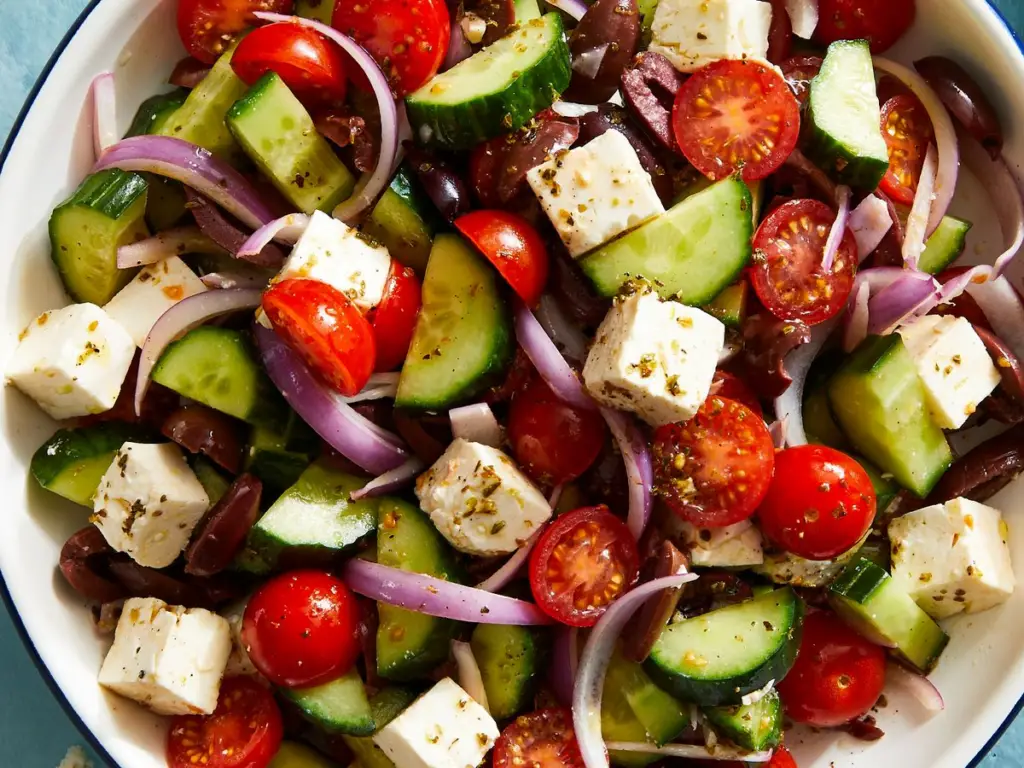
History and Background of Greek Salad
Greek salad, known in Greece as “Horiatiki” or village salad, is a reflection of the simplicity and the seasonality that characterizes Greek cuisine. This dish is a staple in Greek households, especially during the summer months when the vegetables are at their peak of freshness.
The salad is a product of the country’s agrarian roots, where each ingredient can be sourced from a family’s garden or local market. It’s a celebration of the Greek ethos of using high-quality, fresh produce, with the colors of the salad—red, green, white—mirroring the hues of the Greek flag, symbolizing the nation’s pride in its culinary heritage.
List of Ingredients for Greek Salad
- 3-4 ripe tomatoes, cut into wedges
- 1 cucumber, sliced into thick half-moons
- 1 green bell pepper, sliced
- 1 red onion, thinly sliced
- A handful of Kalamata olives
- 200 grams (7 ounces) of feta cheese, sliced or crumbled
- Extra virgin olive oil, for drizzling
- Red wine vinegar, to taste
- Dried oregano, to taste
- Sea salt, to taste
- Freshly ground black pepper, to taste
- (Optional) Capers, to taste
Greek food recipes for Greek Salad
Prepare the Vegetables
- Begin by washing all the vegetables thoroughly. Cut the tomatoes into wedges or large chunks. Slice the cucumber into thick half-moons, so they retain a crunch. Core and slice the green bell pepper into rings or strips. Peel and thinly slice the red onion into rings.
Assemble the Salad
- In a large salad bowl, combine the tomatoes, cucumbers, green bell pepper, and red onions. Toss them lightly to distribute the vegetables evenly.
Add the Olives and Cheese
- Scatter the Kalamata olives over the salad. Place the feta cheese on top, either as a large slab or crumbled into large pieces. If using capers, sprinkle them over the salad as well.
Season the Salad
- Drizzle the salad generously with extra virgin olive oil. The oil is a key flavor component, so use the best quality you have.
- Splash a bit of red wine vinegar over the top to add a zesty acidity.
- Season with sea salt and freshly ground black pepper to taste. Be cautious with the salt as the olives and feta will also contribute saltiness.
Add the Herbs
- Sprinkle dried oregano over the salad, giving it that quintessential Greek flavor.
Serve
- Greek salad is traditionally served with the vegetables in large pieces, as it’s meant to be a substantial part of the meal. It’s best enjoyed fresh, with a slice of crusty bread to soak up the delicious olive oil and juices.
Greek salad is more than just a dish; it’s a representation of the Greek landscape on a plate, a testament to the country’s love affair with fresh, flavorful, and simple ingredients.
Greek Cuisine – Tiropita

History and Background of Tiropita
Tiropita, also known as Greek cheese pie, is a savory pastry that is part of a family of Greek dishes with filled phyllo, which includes spanakopita (spinach pie) and the sweet dessert baklava. The origins of tiropita can be traced back to Ancient Greece, where a similar recipe called “plakountas tetyromenous” was enjoyed.
The modern version of tiropita became popular in Greece in the 20th century, especially as a quick snack or a breakfast item. It is a versatile dish that can be made in large pans and cut into pieces, or as individual triangles, often found in Greek bakeries and homes.
The filling typically consists of a mix of cheeses, often including feta, which provides a tangy flavor, and it’s seasoned with herbs like dill or mint.
List of Ingredients for Tiropita
For the Filling
- 300 grams (10 ounces) of feta cheese, crumbled
- 100 grams (3.5 ounces) of ricotta or cottage cheese
- 2 eggs, lightly beaten
- A handful of fresh dill, chopped (optional)
- A handful of fresh parsley, chopped (optional)
- Salt and pepper to taste
The Pastry
- 1 package of phyllo dough, thawed
- About 1/2 cup of unsalted butter, melted
- Olive oil for brushing (optional)
Greek food recipes for Tiropita
Prepare the Filling
- In a large mixing bowl, combine the crumbled feta cheese and ricotta or cottage cheese.
- Mix well to combine.
- Stir in the beaten eggs until the mixture is well combined.
- Add the chopped dill and parsley if using, and season with a little salt (be cautious as feta is already salty) and pepper to taste. Set aside.
Assemble the Tiropita
- Preheat your oven to 350°F (175°C).
- Brush a baking dish with some of the melted butter or olive oil.
- Lay a sheet of phyllo dough in the dish and brush with melted butter or olive oil.
- Repeat with more sheets, layering about 4-6 sheets for the bottom of the pie.
- Spread the cheese mixture over the phyllo base evenly.
- Cover the cheese mixture with more phyllo sheets, again brushing each sheet with butter or olive oil, until you have 4-6 layers.
- Fold any overhanging phyllo sheets over the top and brush with more butter or oil.
Bake the Tiropita
- Before baking, score the top layer of phyllo with a sharp knife to mark out serving squares or rectangles.
- Bake in the preheated oven for about 45 minutes to an hour, or until the phyllo is golden brown and crisp, and the filling is set.
Serve
- Let the tiropita cool slightly before cutting through the score marks.
- Serve warm or at room temperature as a snack, appetizer, or part of a meal.
Tiropita is a celebration of the Greek love for cheese and phyllo pastry. It’s a dish that can be enjoyed at any time of the day and is a staple in Greek cuisine for its delightful combination of crispy pastry and creamy, savory filling.
Moussaka: The Quintessential Greek Dish
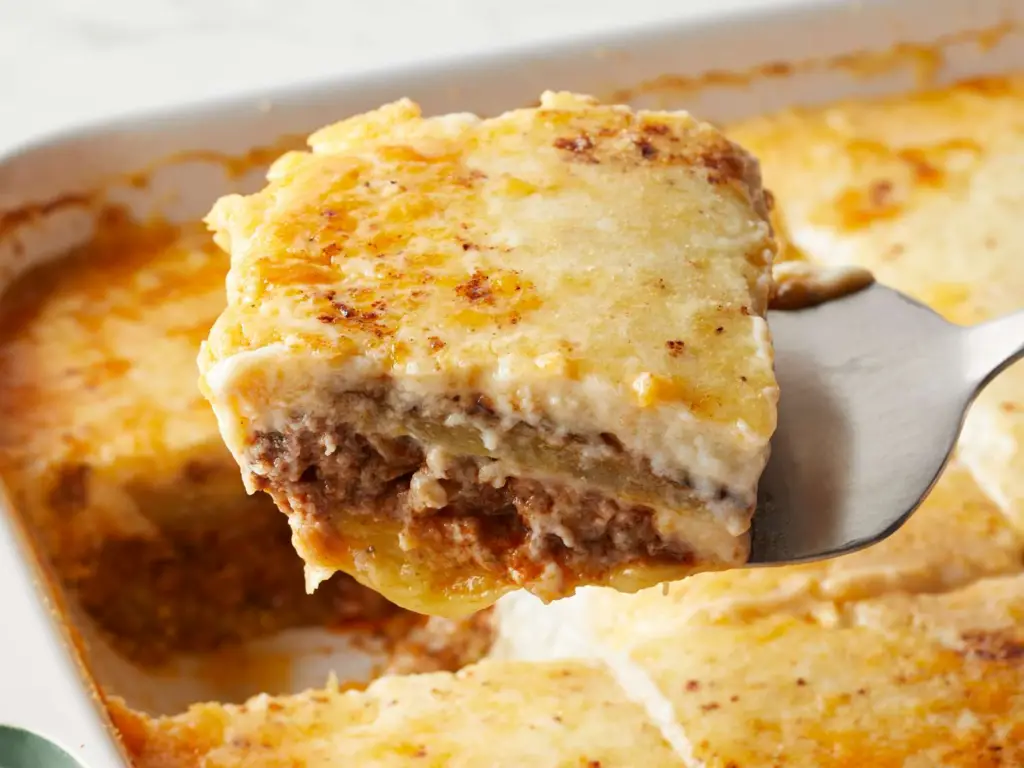
When it comes to traditional Greek food, moussaka is the national dish of Greece. This beloved classic is a layered casserole that includes eggplant, minced meat, and a creamy béchamel sauce. The dish is spiced with cinnamon and nutmeg, giving it a unique and delicious flavor that sets it apart from other casseroles.
Authentic Greek recipes for moussaka vary slightly from region to region, but the basic ingredients remain the same. In some parts of Greece, potatoes are used in place of eggplant, while in others, zucchini is added to the mix. Regardless of the variation, what makes moussaka so special is its rich, hearty flavor that is perfect for any occasion.
In Greece, moussaka is commonly served as the main course for dinner, and it pairs well with a fresh Greek salad or some crispy bread. It’s also popular in home kitchens, where families have their own unique recipes that have been passed down through generations.
If you’re looking to try your hand at making moussaka, there are countless authentic Greek recipes available online. Try making a classic version with eggplant and beef or switch it up with a vegetarian option that includes lentils and mushrooms.
No matter how you choose to enjoy moussaka, it’s clear that this dish is a quintessential part of Greek cuisine. Its hearty flavors and comforting warmth make it a popular choice for both locals and visitors alike.
Here’s a recipe for Greek Moussaka:
Greek Cuisine – Ingredients: Moussaka
For the Eggplant Layer
- 3 large eggplants, sliced into 1/4-inch thick rounds
- Olive oil
- Salt
The Meat Sauce
- 500g ground lamb or beef
- 1 large onion, finely chopped
- 2 cloves garlic, minced
- 1 can (400g) diced tomatoes
- 1/4 cup red wine (optional)
- 2 tablespoons tomato paste
- 1 teaspoon ground cinnamon
- 1/2 teaspoon ground allspice
- Salt and pepper to taste
- A handful of fresh parsley, chopped
For the Béchamel Sauce
- 4 cups milk
- 1/2 cup unsalted butter
- 1/2 cup all-purpose flour
- 1/4 teaspoon ground nutmeg
- Salt and white pepper to taste
- 1 cup grated Parmesan cheese
- 2 egg yolks, beaten
Greek food recipes Instructions:
Eggplant Layer
- Preheat your oven to 200°C (390°F).
- Brush both sides of the eggplant slices with olive oil and season with salt.
- Place them on a baking sheet and bake for 20-25 minutes or until softened and lightly browned. Set aside.
Meat Sauce
- In a large skillet, heat some olive oil over medium heat. Add the onions and garlic and sauté until translucent.
- Add the ground meat and cook until browned.
- Stir in the diced tomatoes, red wine (if using), tomato paste, cinnamon, allspice, salt, and pepper. Let it simmer for about 20 minutes until the sauce thickens. Stir in the chopped parsley.
Béchamel Sauce
- In a saucepan, melt the butter over medium heat. Add the flour and whisk continuously to make a roux. Cook for a couple of minutes.
- Gradually add the milk, whisking continuously to prevent lumps. Continue cooking and whisking until the sauce thickens.
- Season with nutmeg, salt, and white pepper. Remove from heat.
- Slowly whisk in the beaten egg yolks and grated Parmesan cheese until smooth.
Assembly
- Preheat your oven to 180°C (350°F).
- In a large baking dish, layer half of the eggplant slices at the bottom.
- Spread half of the meat sauce over the eggplant.
- Repeat with the remaining eggplant slices and meat sauce.
- Pour the béchamel sauce over the top, spreading it evenly.
- Bake in the oven for 45 minutes or until the top is golden brown and bubbly.
Allow the moussaka to cool for a bit before serving. Enjoy your Greek Moussaka!
Greek Cuisine – Spanakopita: A Greek Spinach Pie

When it comes to traditional Greek food, spanakopita stands out as a beloved dish. This delicious spinach pie is a staple in Greek cuisine, and its authentic recipe has been passed down through generations. Spanakopita is a savory pastry made with layers of flaky phyllo dough and a filling of spinach, feta cheese, onions, and herbs.
One of the secrets of the authentic Greek recipe for spanakopita is the use of high-quality ingredients. Fresh spinach, crumbled feta cheese, and a blend of herbs, including dill and parsley, give this dish its signature flavor. The layers of phyllo pastry are brushed with olive oil and baked until crisp and golden.
A bite of spanakopita is a perfect representation of the delicious and healthy traditional Greek food. The combination of the spinach and feta cheese provides an excellent source of vitamins and minerals, while the phyllo pastry adds a satisfying crunch to each bite.
Spanakopita is a popular Greek dish not only in Greece but worldwide. It is a great vegetarian option that can be served as an appetizer or a main course. In Greek households, it is often served as a meze, a small plate served with ouzo or other traditional Greek drinks.
Whether you’re a seasoned fan of Greek cuisine or just discovering it for the first time, you’re sure to fall in love with the delicious flavors of spanakopita. This authentic Greek recipe is a perfect example of the richness and diversity of popular Greek food.
Here’s a recipe for Greek Spanakopita:
Greek Cuisine – Spanakopita Ingredients
For the Filling
- 500g fresh spinach, washed and chopped
- 200g feta cheese, crumbled
- 1 large onion, finely chopped
- 2-3 green onions, finely chopped
- 2 cloves garlic, minced
- 2 large eggs, beaten
- 1/4 cup fresh dill, chopped (or use parsley)
- 1/4 cup olive oil
- Salt and pepper to taste
- A pinch of grated nutmeg
For the Assembly
- 1 package phyllo dough (about 16 sheets)
- 1 cup melted unsalted butter or olive oil
Greek food recipes Instructions:
Filling
- In a large skillet, heat the olive oil over medium heat. Add the onions, green onions, and garlic and sauté until translucent.
- Add the chopped spinach and cook until wilted. Remove from heat and let it cool.
- Once cooled, squeeze out any excess liquid from the spinach mixture.
- In a large mixing bowl, combine the spinach mixture, crumbled feta, dill, beaten eggs, salt, pepper, and nutmeg. Mix well.
Assembly
- Preheat your oven to 180°C (350°F).
- Brush a baking dish with melted butter or olive oil.
- Lay one sheet of phyllo dough in the dish and brush with melted butter or olive oil. Repeat this process, layering and brushing each sheet, until you have about 8 sheets layered.
- Spread the spinach and feta mixture evenly over the phyllo layers.
- Continue layering and brushing the remaining phyllo sheets on top of the filling.
- Using a sharp knife, score the top layers of phyllo into squares or triangles.
- Bake in the oven for 40-45 minutes or until the phyllo is golden brown and crispy.
Allow the Spanakopita to cool slightly before serving. Enjoy your Greek Spanakopita!
Note: Spanakopita can also be made into individual triangles or rolls for appetizer-sized portions. Adjust the baking time accordingly if making smaller portions.
Greek Cuisine – Souvlaki: A Greek Street Food Favorite
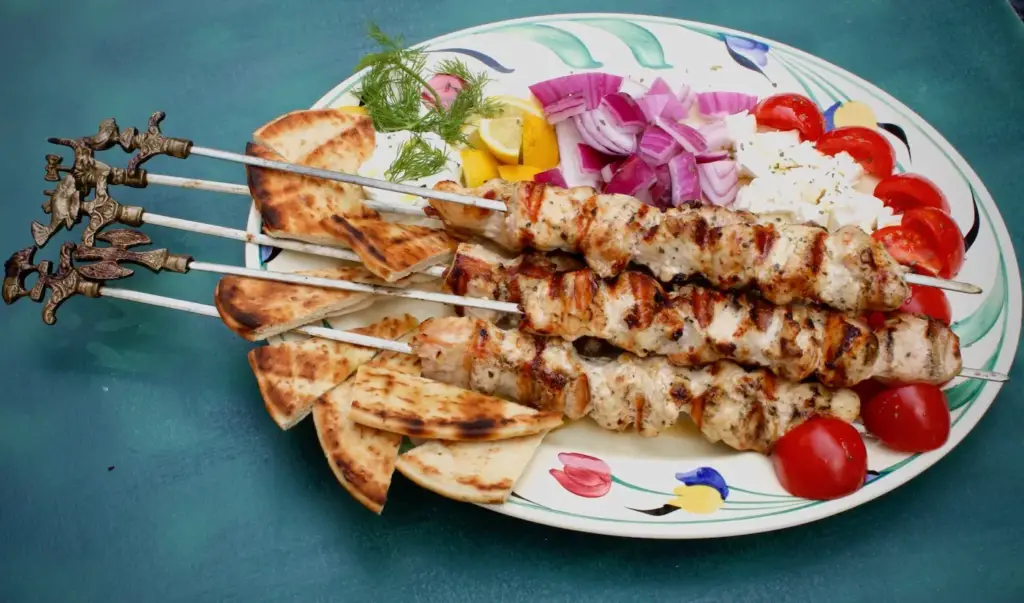
When it comes to traditional Greek food, souvlaki is a must-try dish. This popular street food has gained immense popularity worldwide and is a staple in Greek cuisine.
The traditional recipe for souvlaki involves skewered and grilled meat, typically pork or chicken, served alongside pita bread, tzatziki sauce, and a traditional Greek salad. The succulent meat is marinated in olive oil, lemon juice, garlic, and herbs before being grilled to perfection.
The cultural significance of souvlaki cannot be overstated. Greeks have been consuming this delicious dish for centuries, and it has become a symbol of Greek cuisine. Whether you’re strolling through the streets of Athens or enjoying souvlaki at a Greek festival in your hometown, you can experience the true essence of Greek culture through this dish.
Souvlaki is not just a popular street food in Greece, but also a famous Greek dish around the world. Many Greek restaurants and food trucks serve souvlaki as their signature dish, and it is a favorite among food enthusiasts.
With its mouth-watering flavors and cultural significance, souvlaki is a prime example of the popularity of traditional Greek food. Its simple yet delicious recipe has made it a beloved dish both in Greece and worldwide, making it a must-try for anyone looking to experience the delights of Greek cuisine.
Here’s a recipe for Greek Souvlaki:
Greek Food – Souvlaki: Ingredients:
For the Marinade:
- 500g pork tenderloin or chicken breast, cut into 1-inch cubes
- 3-4 cloves garlic, minced
- Juice of 1 lemon
- 1/4 cup olive oil
- 2 teaspoons dried oregano
- 1 teaspoon dried rosemary (optional)
- Salt and pepper to taste
For Serving:
- Pita bread
- Tzatziki sauce
- Sliced tomatoes
- Sliced onions
- Lettuce
- Feta cheese (optional)
Greek Food – Souvlaki: Preparation Instructions:
Marinade:
- In a large bowl, combine the minced garlic, lemon juice, olive oil, oregano, rosemary (if using), salt, and pepper. Mix well.
- Add the meat cubes to the marinade, and ensure the marinade covers them. Cover the bowl with plastic wrap and refrigerate for at least 2 hours, preferably overnight.
Grilling:
- If using wooden skewers, soak them in water for at least 30 minutes before grilling to prevent them from burning.
- Preheat a grill or grill pan over medium-high heat.
- Thread the marinated meat cubes onto the skewers.
- Place the skewers on the grill and cook for 10-12 minutes and turn them occasionally, until the meat is cooked through and has a nice char on the outside.
Serving:
- Warm the pita bread on the grill for about 1 minute on each side.
- Serve the souvlaki skewers with pita bread, tzatziki sauce, sliced tomatoes, onions, lettuce, and feta cheese if desired.
Enjoy your Greek Souvlaki!
Note: You can serve Souvlaki with a side of Greek salad or roasted potatoes. Adjust the ingredients and accompaniments to your liking!
Greek Cuisine – Galaktoboureko

History and Background of Galaktoboureko
Galaktoboureko is a beloved traditional Greek dessert, known for its sweet and creamy custard encased in flaky phyllo pastry, all soaked in a lemon-scented syrup. The dessert’s name is a compound of two Greek words: “galaktos,” meaning milk, and “boureko.” They refersto a filled pastry, derived from the Turkish “börek,” indicating the shared culinary influences during the Ottoman Empire’s presence in Greece.
This dessert is a relatively modern addition to Greek cuisine, likely developed in the early 20th century as a variation of custard-filled pastries that were popular in the Ottoman cuisine. It is a staple in Greek bakeries and is particularly favored during celebrations and festive occasions.
Greek Food – List of Ingredients for Galaktoboureko
For the Custard
- 1 liter (about 4 cups) of whole milk
- 1 cup of fine semolina
- 3/4 cup of sugar
- 4 large eggs
- 1 teaspoon of vanilla extract
- A pinch of salt
- Zest of 1 lemon
The Syrup
- 1 cup of water
- 1 cup of sugar
- 1/2 cup of honey
- 1 cinnamon stick
- Peel of 1 lemon
- Juice of half a lemon
The Assembly
- 1 package of phyllo dough, thawed
- About 1 cup of unsalted butter, melted
Greek food recipe for Galaktoboureko
Prepare the Syrup
- Combine the water, sugar, honey, cinnamon stick, and lemon peel in a saucepan over medium heat.
- Bring to a boil, then reduce the heat and simmer for about 5-10 minutes until slightly thickened.
- Remove from heat, add the lemon juice, and set aside to cool.
Make the Custard
- In another saucepan, heat the milk over medium heat until just hot, but not boiling.
- In a bowl, whisk the eggs, sugar, vanilla extract, and lemon zest until well combined.
- Gradually add the semolina to the milk, whisking constantly to prevent lumps.
- Slowly pour the egg mixture into the hot milk, whisking continuously.
- Cook over low heat, stirring constantly, until the mixture thickens into a custard.
- Remove from heat and let it cool slightly.
Assemble the Galaktoboureko
- Preheat your oven to 350°F (175°C).
- Brush a baking dish with melted butter.
- Lay down a sheet of phyllo, brush with butter, and repeat, layering about half the phyllo sheets.
- Pour the custard over the phyllo layers and spread evenly.
- Cover the custard with the remaining phyllo sheets, brushing each sheet with butter as before.
- Trim any excess phyllo and tuck the edges in. Score the top layers with a sharp knife to mark serving squares.
- Bake for about 45 minutes to an hour, or until the phyllo is golden brown and crisp.
Finish with Syrup
- As soon as the Galaktoboureko comes out of the oven, slowly pour the cooled syrup over the hot pastry.
- Allow the Galaktoboureko to cool and absorb the syrup before serving.
Galaktoboureko is best enjoyed the day it’s made, as the phyllo is at its crispiest, contrasting beautifully with the creamy custard. It’s a rich, sweet dessert that embodies the spirit of Greek hospitality and the love of life’s sweeter moments.
Greek Cuisine – Baklava

History and Background of Baklava
Baklava is a rich, sweet pastry that is a jewel in the crown of Greek desserts, though its origins are a tapestry woven from many cultures. The layers of filo pastry filled with chopped nuts and sweetened with syrup or honey are commonly associated with the cuisines of the Ottoman Empire.
The dessert has a storied history in Middle Eastern countries, with each region offering its own twist. The Greeks adopted and adapted baklava, infusing it with local flavors such as honey and cinnamon.
It is thought that the introduction of thin dough technique by the Greeks and the cooking method perfected in the palaces of Istanbul combined to create the baklava we know today. This dessert is often found in Greek tavernas and homes, especially during celebrations and religious holidays.
Greek Food – Ingredients for Baklava
For the Pastry and Filling
- 1 package of phyllo dough, thawed
- 2 cups of mixed nuts (such as walnuts, pistachios, and almonds), finely chopped
- 1 teaspoon of ground cinnamon
- 1 cup of unsalted butter, melted
The Syrup
- 1 cup of water
- 1 cup of sugar
- 1/2 cup of honey
- 1-2 sticks of cinnamon
- 1 strip of lemon peel
- A few cloves (optional)
- A splash of lemon juice or rose water (optional for flavor)
Greek food recipe for Baklava
Prepare the Syrup
- Combine the water, sugar, cinnamon sticks, lemon peel, and cloves (if using) in a saucepan over medium heat.
- Bring to a boil, then reduce the heat and simmer for about 10 minutes until the syrup is slightly thickened.
- Stir in the honey and continue to simmer for another 2-3 minutes.
- Remove from heat and add a splash of lemon juice or rose water if desired. Set aside to cool.
Prepare the Nut Mixture
- In a bowl, mix the finely chopped nuts with the ground cinnamon until well combined.
Assemble the Baklava
- Preheat your oven to 350°F (175°C).
- Brush the bottom and sides of a 9×13 inch baking pan with some of the melted butter.
- Place a sheet of phyllo in the pan and brush with melted butter. Repeat with more sheets, about 8-10 layers, brushing each with butter.
- Sprinkle a thin layer of the nut mixture over the phyllo.
- Continue layering phyllo sheets, brushing each with butter, and adding nut layers every 2-3 sheets. Aim to use up the nuts in 4-5 layers.
- Finish with a top layer of about 6-8 phyllo sheets, brushing each with butter.
Cut and Bake
- Using a sharp knife, cut the baklava into diamonds or squares before baking.
- Bake for about 50 minutes to an hour, or until the baklava is golden and crisp.
Finish with Syrup
- As soon as the baklava comes out of the oven, pour the cooled syrup over the hot pastry evenly.
- Allow the baklava to fully absorb the syrup and cool before serving.
Baklava is a dessert that is both a treat for the senses and a testament to the rich tapestry of culinary history in Greece. Its flaky layers and sweet, nutty filling make it a beloved end to any meal or a sumptuous snack to be enjoyed with coffee or tea.
Conclusion
Greek culinary culture is rich in tradition and flavor. From the national dish of Greece, moussaka, to popular favorites like spanakopita and souvlaki, Greek cuisine has left its mark on the world of gastronomy. It’s not just the food itself, but the spirit of hospitality and warmth that accompanies every meal. Greek cuisine is more than just sustenance; it’s an expression of the Greek way of life.
Whether you’re eating at a taverna in Athens or at a Greek restaurant in your hometown, the flavors and aromas of traditional Greek food will transport you to the sunny shores of Greece. It’s not just about the taste, but the memories and emotions that come with each bite.
At the heart of Greek culinary culture is the national dish of Greece, moussaka. This hearty casserole features layers of eggplant, minced meat, and creamy béchamel sauce, and is a staple on every Greek family’s dinner table. Other famous Greek dishes include spanakopita, featuring layers of phyllo pastry filled with spinach, feta cheese, and herbs, and souvlaki, a popular street food featuring skewered and grilled meat served with pita bread and tzatziki sauce.
Whether you’re new to Greek cuisine or a seasoned veteran, there’s always something new to try and discover. The flavors and traditions of Greek culinary culture are as varied as the country’s geography and history, and every dish tells a unique story.
So, whether you’re in Greece or enjoying Greek food elsewhere, take a moment to savor the flavors of this ancient cuisine. From the national dish of Greece to popular favorites, Greek culinary culture is a delight for the senses. As they say in Greece, “kali orexi” – bon appétit!
FAQ’s
What is the national dish of Greece?
The national dish of Greece is moussaka.
What is Greek cuisine known for?
Greek cuisine is known for its rich history, traditional recipes, and the use of fresh ingredients like olive oil, herbs, and spices.
What is moussaka?
Moussaka is a traditional Greek dish that consists of layers of eggplant, minced meat, and a creamy béchamel sauce.
What is spanakopita?
Spanakopita is a Greek spinach pie made with layers of phyllo pastry filled with a mixture of spinach, feta cheese, and herbs.
What is souvlaki?
Souvlaki is a popular Greek street food dish made with skewered and grilled meat, typically pork or chicken, served alongside pita bread, tzatziki sauce, and Greek salad.
What makes Greek food recipes special?
Greek food is special because it reflects the country’s rich culinary culture and traditions, using fresh ingredients and traditional recipes that have been passed down through generations.
What is the Best Greek Food?
The best Greek food is a subjective matter, a journey of personal preference influenced by individual tastes and experiences. Whether you find solace in the robust flavors of moussaka, the grilled perfection of souvlaki, the delicate layers of spanakopita, or the refreshing crunch of a Greek salad, each dish invites you to savor the essence of Greece on a plate.
In the end, the beauty of Greek cuisine lies not in determining a single champion but in embracing the diverse tapestry of flavors that together create an unforgettable culinary mosaic.

